How long following the John Wilkes' return to St. Charles was it that they sensed they made a mistake by leaving Star Valley we, perhaps, will never know. It has become quite evident there were regrets or else why did they prepare to again return?
No date can be given to the actual trip, nor do we have a single word relative to it. In all likelihood they may have made a scouting trip in advance of their permanent trip either by Grandpa Wilkes on horseback or, perhaps, a trip in a light wagon or buggy with Grandma Martha accompanying him. There has been circulated a family tradition that they returned to the same cabin they left at the head of Swift Creek. If such be true, it was not for long, perhaps, only long enough for them to construct another home at a different location. We must realize they had been back in St. Charles for at least four to five years and, possible, from six to seven. There had been too much homesteading going on during those years for them to even hope the choice spots in the Valley had not been taken up. They had forfeited the choice spots by their long absence back to St. Charles following their first trip.
All their children to date had been born in St. Charles with Baby Noen being born on the 24th of January 1887. Sarah Leola (Aunt Lola Holbrook) was born 1st of January 1890 in Afton which gives us two known dates between which their second move to Star Valley was made. We simply do not find any other date of any family activity between those two dates and the first date following Lola's birthdate is Aunt Lottie's baptismal date which occurred on the 6th of August 1890 in Afton. For the present, then, we have to settle on the date of the family moving from St. Charles to Afton as being sometime between the 24th of January of 1887 and the 1st of January 1890.
Before they left St. Charles this second time, they apparently learned there yet was federal government land available for homesteading. In the meantime - during their absence back to St. Charles - considerable activity had been going on and the town of Afton had been platted not far from the very site where they had first built their cabin on the south side of the entrance of Swift Creek from the mountains on the east of the Valley.
The family selected an available 160 acres approximately two miles west of the town-site of Afton which was located near Salt River. In once sense this spot was, at the time more productive than was the area up next to the mountains where they had previously settled. Certainly the area was not so dry and barren nor so rocky for it was natural meadowland and yet sufficiently close to Swift Creek that probably water-rights could be gotten.
In all probability these 160 acres were among the many acres up and down the Salt River where the Indians had camped over the previous centuries as had been described by those who had written of the valley. Re-quoting from Velma Linford's article describing the Valley as was referred to on page 184 - "-They spoke of it as a land where grass was plentiful for their horses and there was a 'heap' of game, fish, and fine water to drink".
Note the position of the John Wilkes homestead below.
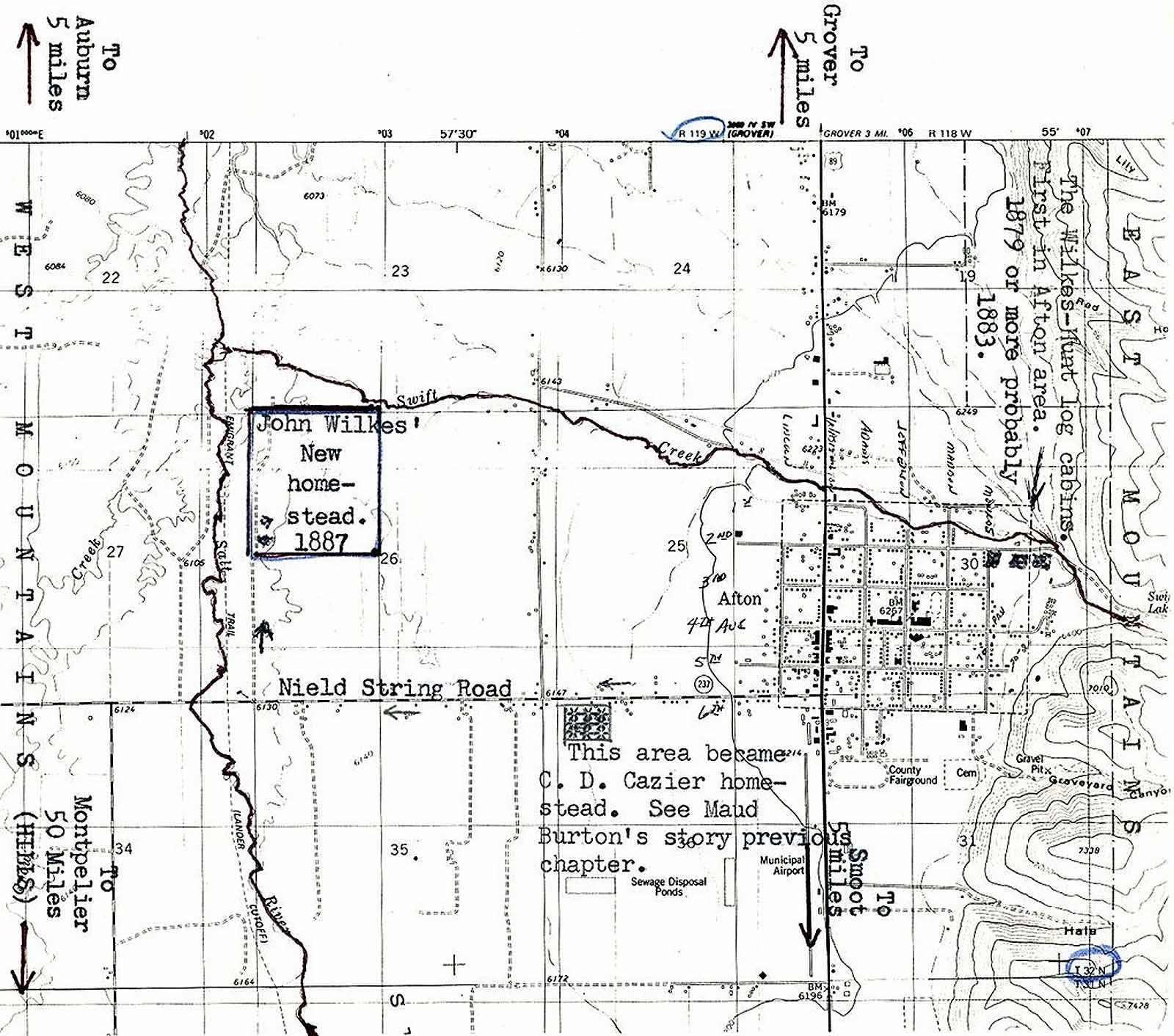
The above copy of the official surveyor's map of the mid-section of Upper Star Valley dealing specifically with the Afton area: The legal description of the Wilkes' homestead reads, " - the Northwest quarter of Section twenty-six, in the Township thirty-two North, of Range one hundred and nineteen West of the Sixth Principal Meridian in Wyoming containing one-hundred and sixty acres". This copy of the map was obtained from the court house in Kemmerer.
Note that section 26 is labeled near center of map and the northwest quarter is outlined. For many years, there has been no house nor farm buildings on this piece of property. It remains simply meadowland. Inquiring of close friends, Bryce and Mona Nield Allred of Burley, Idaho, and from whom the history of Afton, written by Maud Burton, was obtained and which was copied in the previous chapter, they, the Allreds, moved from this very area on the map some fifteen years ago, report the probably route from Afton to the Wilkes' homestead would have been leaving the southwest corner of Afton, going two miles west and thence one-half mile north - west on Nield String Road.
John Wilkes' daughter, Aunt Mabel, has acclaimed her father to have been a good fisherman and a good hunter which, undoubtedly, was the source of part of the family's food needs. The homestead was in a locality where we can assume wild meadow hay would be their major crop which, in turn, implies they would have had a few cows both for beef and for milk from which cheese and butter could have become by-products. By 1890 freighters were taking dairy products and eggs out of the Valley to such places as Montpelier, Evanston and Almy, a mining town larger than any of the surrounding towns. Too, local businesses were beginning to open up in Afton requiring manufactured goods to be brought in so, from about this time on, freights had loads going and coming.
Again, reviewing the family, we can see the children were growing up. By 1890 Johnnie was 16 years old, Mattie 14. Ed was nearing 12 so he too, was able to handle cows and horses. Because of the disabilities of their father, the boys would have learned early to run the farm. Schooling in the school room was limited to all the children, but they each had a few years and were taught the simple skills of education such as reading, writing and arithmetic. The writer's mother Hettie, claimed a fourth grade education and probably the older children of the family could boast of but little more. The younger ones, naturally, had greater opportunities and what was true of the Wilkes' children, was true with most of the families then growing up.
Another little girl came to John and Martha and they named her Nettie. She was born on the 22 December 1893, undoubtedly at home west of Afton. Midwifery was undoubtedly the source of help in childbirth in such pioneering conditions. It might be noted here that the Afton ward records gives Nettie's birth date as of 22 December 1892, and that she was blessed on the 2nd of March of 1893. Most branches of the family are agreed on 22 December 1893.
Let us remain cognizant of the fact that little Nettie was the eighth child of the family, but just before she arrived - two months, in fact before - eldest daughter, Mattie, married so the vacancy made by her leaving home was shortly re-occupied by Nettie. Mattie married a young man by the name of John Lorin Walker and the young couple made their home for the present in Star Valley.
The Homestead Act which was passed by congress in 1862 served two general purposes: 1st, it was meant to bring a stability to the country by providing a contented and permanent populace and secondly, it was to give homes to those who were seeking homes and provide families with economic stability.
Certainly both these purposes were served in the instance of Star Valley and the John Wilkes family. Towns and cities were founded and farmland became cultivated as a result of the government portioning out its public domain to those who would put forth the effort to build homes on free land or at little cost. In addition to a limited number of acres granted, in such areas as Star Valley, where the acres without water would be of little use, the government also granted and guaranteed a restricted amount of water from the streams which flowed from the mountains and would be allocated to the homesteader.
To receive the homestead and the water rights, it became incumbent upon the homesteader to build a home, fence the allotted acres and cultivate and care for the place for a designated period of time - usually five years - before receiving a clear title to the land or what was then termed a patent.
The John Wilkes family conformed to these requirements as is evidenced below.
After completing his obligation by fulfilling his part of the Homestead contract, John Wilkes, filed for clear title to the 160 acres of land, and after showing evidence, the U.S. government granted this Title.
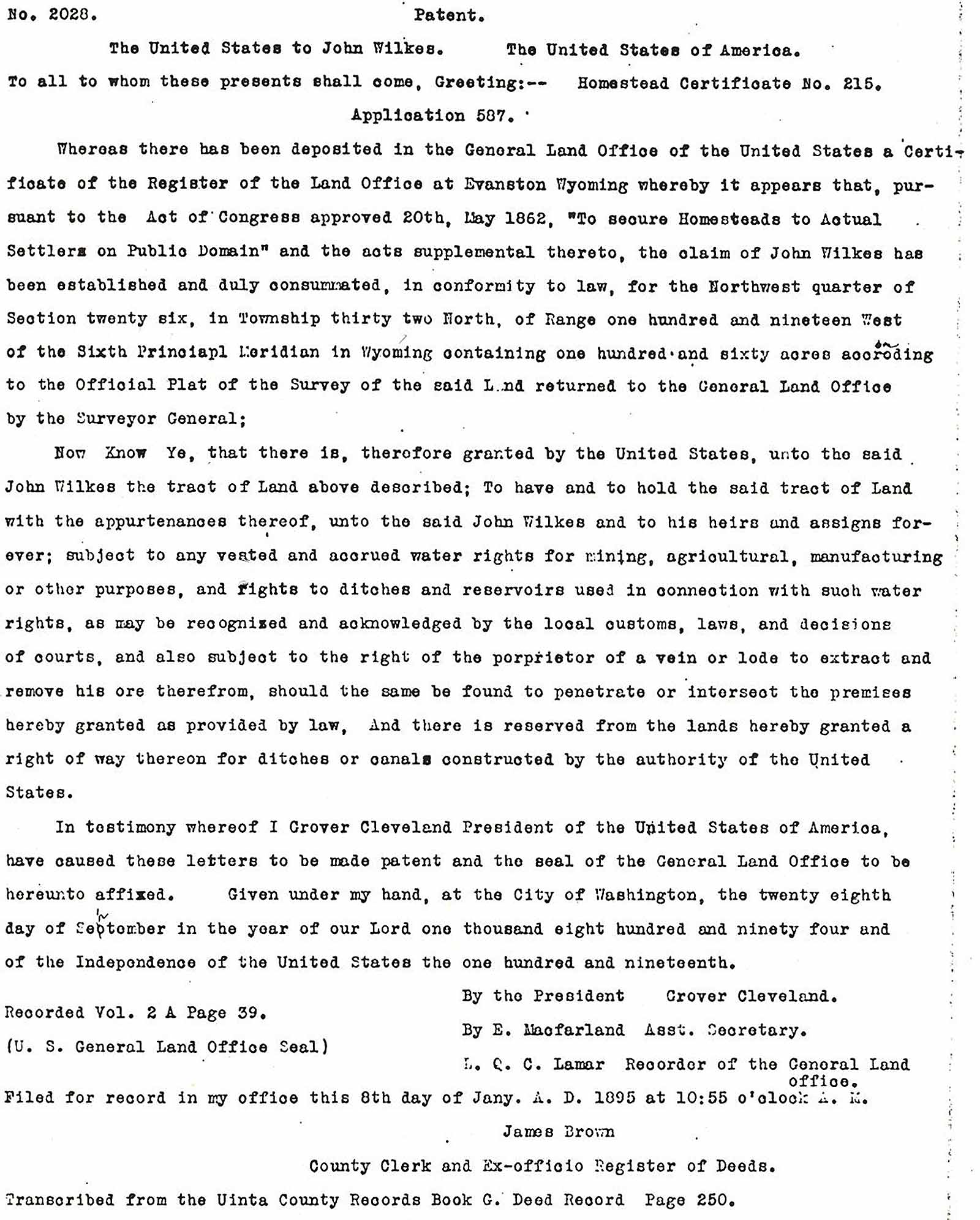
As can be noted, the original patent was dated the 28th day of September 1894 and was filed in the County Clerk's office in Evanston, Wyoming, at 10:55 o'clock the 8th day of January 1895.
Would it be unfair to make the statement that, apparently, the Wilkes family was not fully satisfied with their new holdings? There were certainly some disadvantages. Realizing they were some two miles from Afton, all traveling had to be done by horse and buggy or sleigh. Even if neighbors shared a school route, were the average homestead 160 acres, that meant neighbors would average one-half mile apart from each other. Other than being this much isolated, many neighbors may not have school children - either too young or older than school age, or perhaps, not even attending school.
If the older boys were employed in town such as, very possibly Johnnie was, - he was 21 in 1895 - and was married in October of that year to Luella Child. The very next spring - just a few months later - he was appointed as postmaster in Thayne in the Lower Valley as well as manager of the Roberts Mercantile Store in the same place, which has to indicate that he had had experience, in all likelihood in the Roberts Brothers store in Afton which was the parent store of the new store in Thayne. The point being attempted here is that very probably Johnny had spent a year or two or more working away from home before becoming married. The home being two miles or more away from town was inconvenient.
A fact which we must face in determining the possibility of the family not liking the situation they found themselves in, despite the fact that they now had clear title to the 160 acres, was the fact that Grandpa Wilkes simply was not adapted to that type of life, nor had he ever been. His physical handicaps very much remained with him. It was not normal for one to like doing what he is physically unable to do.
On the other hand, the homestead had been good to the Wilkes family. Six, seven or eight years after they moved onto the place with absolutely nothing, they now owned, clear of indebtedness, 160 acres of good meadow land and, by now, undoubtedly, a few head of livestock - perhaps a few head of cattle, a team or two of horses, and other smaller animals such as sheep, pigs, and a few chickens. They had a dream and it had taken a long time for the dream to be realized. After all, Grandpa Wilkes was now 43 years of age - Grandma, four to five years younger. Most likely they thought they had had their family with Nettie now the baby.
Without belaboring the point, we can't say they were not happy with the condition they found themselves in, but they had other goals. They didn't want to always be on that particular farm - or, perhaps, a farm at all. Their thinking was, "Let's use this as a stepping stone to another way of life". And they did!
As has been previously stated, the town of Afton had its beginning following their first brief stay at the log cabin at the head of Swift Creek prior to their return to St. Charles for a few years. By the time of their return in about 1887 and during the years they lived on their homestead, the town of Afton had probably been incorporated, at least to the extent that the town had jurisdiction over a given area of the land within the town-site.
Even before the Wilkes family had officially obtained their Patent or Title to the 160 acres of homestead, Grandpa's dream for something more suitable to him and his family was taking place. It was uncanny. Some Body, up there, had a hold of Grandpa's hand. To this writer it seems that a miracle was taking place and probably Grandpa John was very much aware of it. His physical body crippled, but his mind was farm from that condition. Some people have an innate ability to anticipate, and Grandpa had this vision.
It would be interesting were we to know the details of his next venture, but we don't. Seemingly, the platting of the town of Afton took place with Grandpa Wilkes knowing exactly what was going on, despite the fact that they were out two miles on the homestead. Before the end of the summer of 1893, the town of Afton was surveyed and platted out into a series of blocks of ten acres each, starting near the mouth of Swift Creek Canyon. Each block was divided into four lots, naturally, containing 2 1/2 acres each. The main road running originally between Smoot and Grover thru Afton from the sound end of the valley to the north was to serve as the main street of Afton on which the early business houses had already been established. Long subsequent to that time, there have been name changes of the streets running north and south and the avenues running east and west. Please note the map just below:

We have no known record that Grandpa Wilkes participated in the survey and the final distribution of the lots all owned by the incorporated town-site. It apparently was concluded that the church house and the school house would be constructed as near the center of the town-site as possible. See block 16, lots 3 and 4 at center of map. Just one block west and the block south of the school and church was clock 20 on which business houses had already been established.
Now, note Block 19 just across the main road to the west. Lost #1 and #2 have been outlined with the added note, "The John Wilkes' Two Town Lots (5 acres) 1893". Also, note that the junction of this main street now labeled Washington Street and Fourth Avenue on which the church building and school of that day were located, became the center of the town. Here we have John Wilkes owning five acres in the very heart of Afton. This is uncanny. It is unthinkable to think no one else of the business people or others of the community were not wanting, nor probably clambering for those two choice lots. The price? We don't know. The Deed reports $13. This could be correct or it may not be correct. The exact price, we understand, need not be quoted on such legal documents. He did pay, at least, that much. How much, if any more, we don't know.
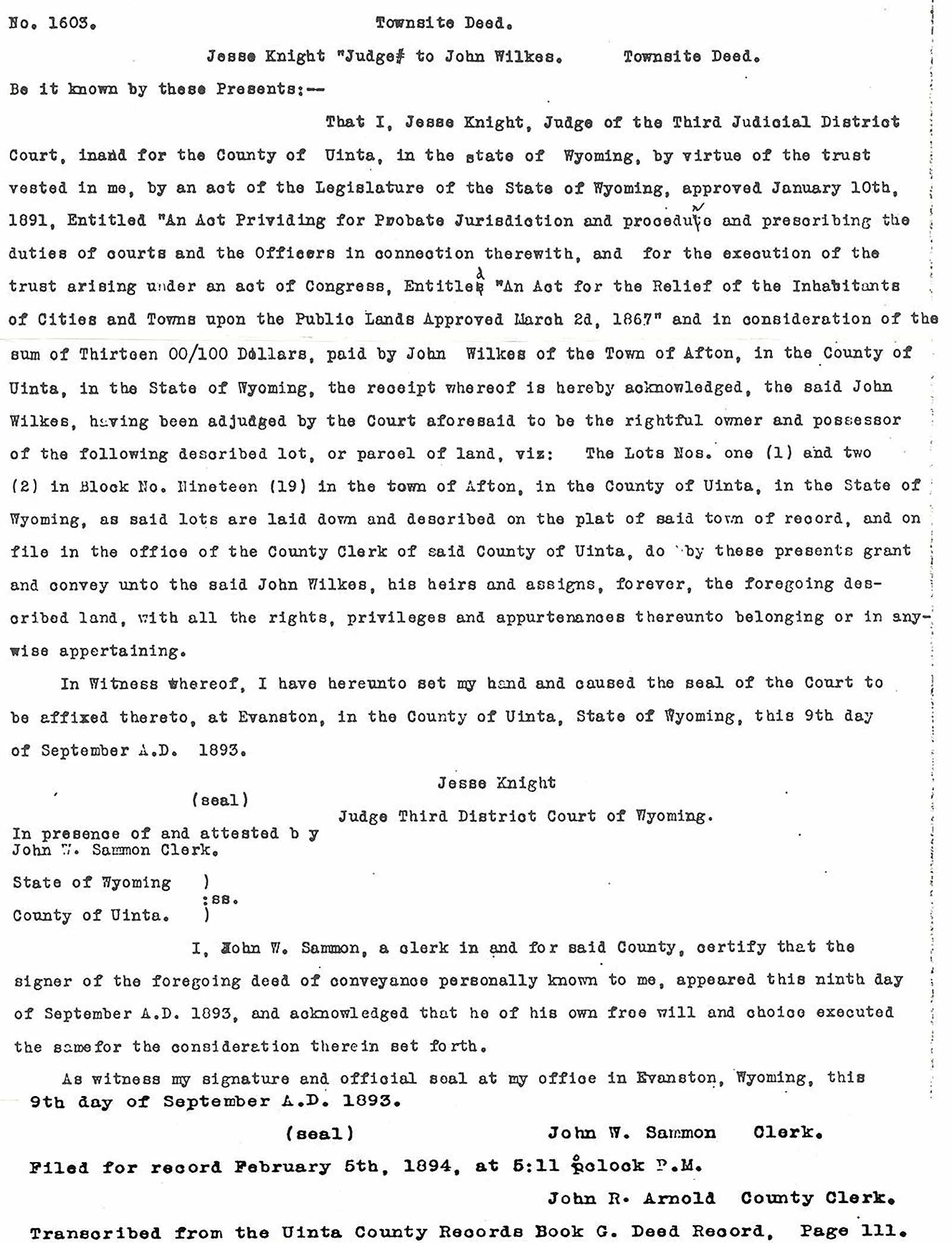
Note the date of the deed - 9th day of September A.D. 1893. It was registered and filed on the 5th day of February 1894, at 5:11 o'clock P.M. Somebody with some influence was in the right place at the right time. Attempting to find the reason, could it have been that the Judge of the Court was aware that John Wilkes, with two brothers-in-law, actually, were the first to settle where the town-site later came into being and spent the winter of 1879-80 in a cabin but, by the time the family returned a few years later, it had been concluded that was where the town of Afton was to be. Is it possible that it was a prearranged trade that was finalized in 1893? Quite possible and the more we ponder, the more likely such could have been.
After obtaining the deed to lots 1 and 2 in Block 19 in Afton - the Wilkes family yet on their 160 acres homestead west of Afton - it became logical that steps should be taken to obtain water rights for the five acres in town and so, application was made. Note the legal Certificate of Appropriation issued by the State Board of Water Control dated 15th day of January 1895.
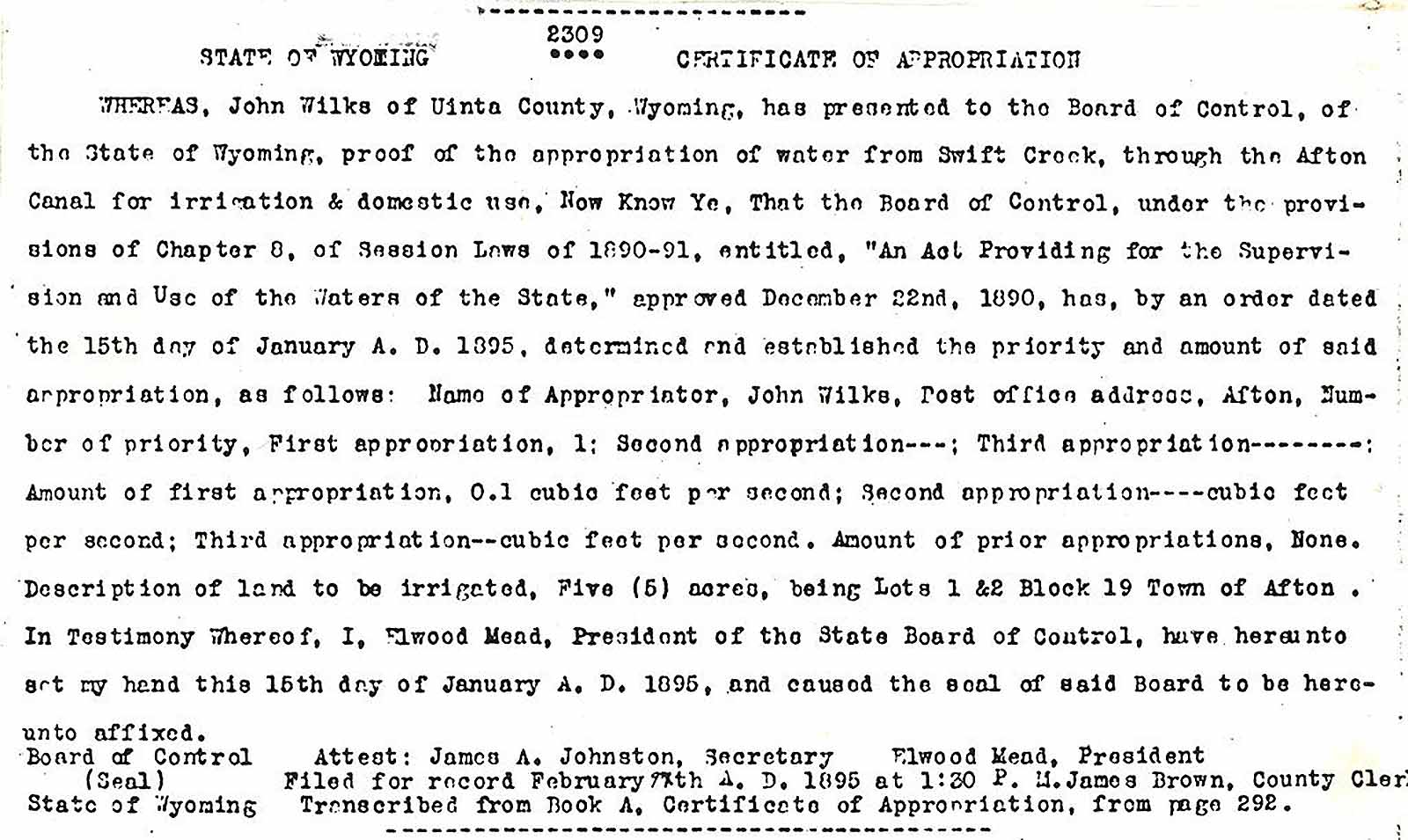
It can plainly be seen now where Grandpa Wilkes' thoughts were during the years the family was struggling on the 160 acre homestead. He was working his way toward town. In all likelihood, as soon as he could get title to the homestead which would provide him with assets, providing he then sold it, which would permit him to construct a house in town. The deeper we involve ourselves in the story, the more easily it is to believe that this favor of obtaining these choice lots was the result of a previous agreement with the original town fathers when the John Wilkes family had returned to their original cabin in 1887 or 88.
We have no evidence when the house was constructed on Lot #1, nor do we have evidence of the disposal of the 160 acre homestead. From our vantage point of nearly 90 years later, we can be assured that both events occurred - the house was built and the homestead was disposed of near or about the same time of each other, probably, about 1895 or 96. Actually, we have nothing to lead us to the exact year the house was built. They became the owners of the lots in 1893, but it would appear logical the water rights would have been obtained before commencing the home, which was not done until January of 1895. The fact that the actual construction of the house was not begun prior to this time cannot be assured.
The house cost money, and did the family have that kind of money before they sold the farm? Remember they still held title to the 160 acres of meadow ground in 1895. We are aware that an up-coming event which we are looking forward to occurred in the summer of 1899 - four years from 1895 where we are now probing - and that was the birth of their last little daughter, Aunt Mabel, who, herself, related to us in a personal interview in 1965 that she was born in the town dwelling and that she did not know how long the house had been built prior to her birth, but she didn't think it was quite brand-new. It was a reasonably large house - two story with probably four or five bedrooms as we shall see later - so it is quite possible it required two summers to construct.
As we review this history of the John and Martha Wilkes family, we simply cannot erase from our minds the extreme hardships of their lives to this time. Long before they knew each other, Martha's tender years were filled with hardship nigh on to extreme poverty at times, at least by our standards of today. While she personally, did not cross the plains, she was every bit as much a pioneer. She was a baby when Johnson's army caused the Mormons for forsake their homes and flee south which covered nearly a year's time before they returned. She was but a small girl of six or seven when her parents took her to St. Charles and pioneered that area, and it was here where she became acquainted with John Wilkes and married him when slightly over 16 1/2 years of age. Despite his handicaps, she saw in him a person she could help. She learned to appreciate him and what he could become. Was it to a degree out of compassion - at least partially so - that she consented to marry him and form a husband-wife partnership? Let's not become too sure her heartfelt compassion was not, at least, a part of the reason. Her heart was like that. She was a wonderful compassionate soul and her real trials were very much, still ahead.
John's struggle with infantile paralysis as a baby was devastating. He took the effects of it to his grave. With his parents he braved the rigors of the trip across the Atlantic and the plains reportedly walking a goodly portion of the way, for a thousand miles whether behind a wagon or handcart with an only pair of shoes which they were attempting to save for the colder weather, and often reserved for a later time despite the sharp stone, the hot sand, and the prickly thistles. After arriving in Utah, he too, escaped with his family from the scare of the U.S. army and returned back to Cache Valley, and it is not at all impossible by the time he was eight or nine years of age, went to California with his father who contracted the 'gold fever', but had to return a year or two later the worse off for that experience.
As a young boy eleven years of age, with his sister and parents, sharing a one-room dirt floored log-cabin with another family during the cold winter nights of the winter of 1863, when, to spare the lives of two or three head of sheep, it was necessary to cuddle up with them in order for human and animal to keep from freezing. These experiences were not fairy tales - they were real events - which he and his family endured simply from the fact that they had no other choice.
From this age on for the next few years, he became the community herdsboy - a full-time summer job day in and day out. In the earlier of these years he is reported to have still been without shoes. Only those who have experienced such a chore can fully realize the monotony of keeping cows and sheep in sight with, at times, only a scrub aspen-tree to provide shade during the heat of the day on the eastern slopes of the dry barren hillsides of St. Charles. Too, there were the days which were not so warm, but bent toward the cooler and cold, but despite the conditions, the animals needed to graze and for them to graze, it required a herdsboy.
A real problem to any normal growing boy was that he was different, and to be different is rough on a boy psychologically. Boys want to be like their peers, and John simply wasn't. The one crippled arm had to have made a great difference to him when, with his playmates two arms would have seemed a luxury to him. There had to have been humiliation as he grew older, and his companions would be able to pick up a pitchfork to toss a forkful of hay, when he was never able to do as well or, when two or three quick shovels full of dirt were needed to keep a dam in a ditch from breaking and, doing the very best he could do would require a longer time. Because of his crippled foot, he could never run and play to the equal of others. Who could criticize him were he a little more sensitive than normal? And it wasn't easy.
Fortunately for John, a young lady saw goodness in him over and above his problems and agreed that if he would do the best he could, she would do more than her share, and they would 'go it together'. As our story to this point has already shown, they did and it wasn't easy.
Returning to years of 1895 and 96 when we are assuming their new home in downtown Afton was being completed, we have to also assume their farm was either sold or traded. This will have to imply they spent from seven to eight years on the farm which, if it was not just what they wanted, it proved a great boon to the family. When a homestead can be obtained for little or no cash outlay, and it sold or was traded seven to eight years later for sufficiently to spare to obtain another farm such as the following described farm, it means the original investment paid off quite handsomely.
As will be noted from the following deed, John Wilkes purchased and paid in full for this over 189 acres from one, Emma J. Dakin, a farm which joined the town-site of Afton to the north and immediately adjacent to the Swift Creek.

The above copy of the Warranty Deed describing the newly acquired farm, was obtain from the Lincoln County courthouse on our recent visit to Kemmerer and shows the legal transfer of ownership to John Wilkes, which farm so far as this writer knows, was never lived on by Grandpa and Grandma Wilkes. They were living in their town home, however, their sons, both Ed and Noen and families separately, did spend some time residing on this nearly 190 acre farm. Below is a rough sketch of the farm as this writer remembers it. In a letter from Cousin Arvilla, she confirmed that this sketch is somewhat accurate.
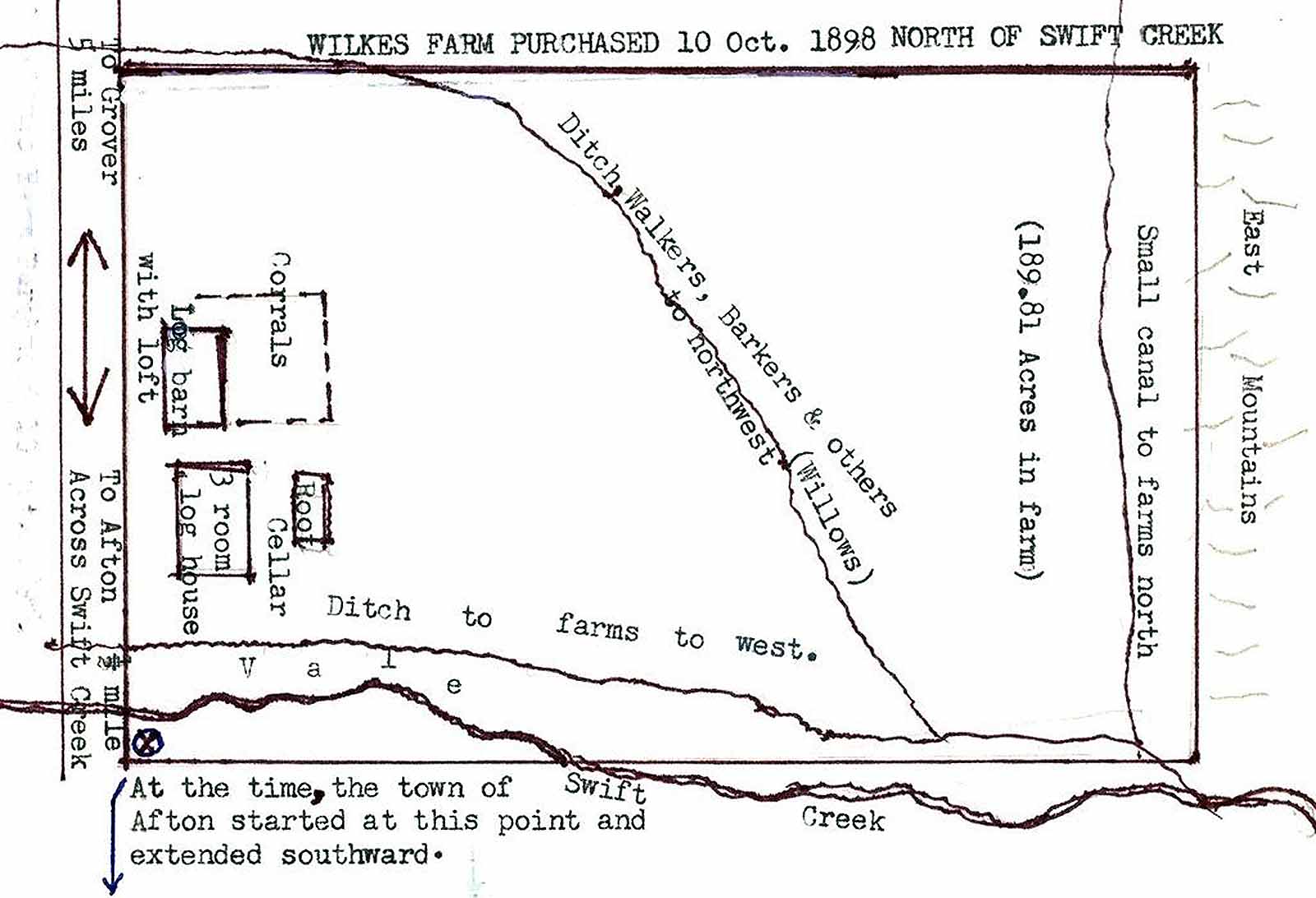
Despite the fact there had been considerable development during the previous ten years since their arrival the second time from St. Charles, it must be remembered the rural areas of the West still remained very much rural and, Star Valley, due to its isolation, remained much the same as it was ten years previous. Star Valley was - and is - a rocky valley. Even for roadways, rocks often had to be dug out with picks and crowbars to make roadways smooth enough for a road. Otherwise, even heavy wagons would be jarred apart. The lighter wagons and buggies were all the more fragile.
Preparing the soil for a seed bed became a challenge and in some rocky areas it simply could not be done but, rather, the farmer had to work around those spots. The greater share of the land was tillable and the limitation of the type of crops in Star Valley was due to elevation rather than condition of the soil. With the elevation being near the 6,000 feet above sea level, only the hardy type crops which are not overly hindered or killed by frost can be raised. Most grasses do reasonable well, such as the meadow grasses and the hardier types of clover. One crop of alfalfa per season and the hardier grains such as barley and oats. Field peas produce reasonably well. Most, if not all, crops are produced for livestock feed which have to be raised for winter feed. It is not uncommon for frost to occur every month of the year, so it can be readily seen that the summer season is relatively short - June, July and August - and if crops will not mature within that length of time, they become a gamble to raise.
Hopefully the reader, and particularly those of the younger generation, will excuse the unintentional naivete of the writer by describing some aspects of farming, even in my time when but a child, but old enough to vividly remember. These described methods were little, if any, different than the practices of farmers during the 1890s and early two decades of the 1900s.
Any plot of ground which was to be seeded such as a garden spot or a grain field, required being plowed. Meadow land, usually, was not plowed, for the grass was wild, which often became sprinkled with clover. On the old Wilkes' homestead two miles west of Afton, it was mostly made up of meadow ground, but when and if they wanted to plant oats, for instances, or a garden, the plow was required to turn the soil over. More plowing was necessary up on their farm which joined Afton to the north, for it was away from the river bottoms and was too dry for natural meadows. Note the picture below for the type of plow in use during the John Wilkes' farming years. (And this writer's early memory)
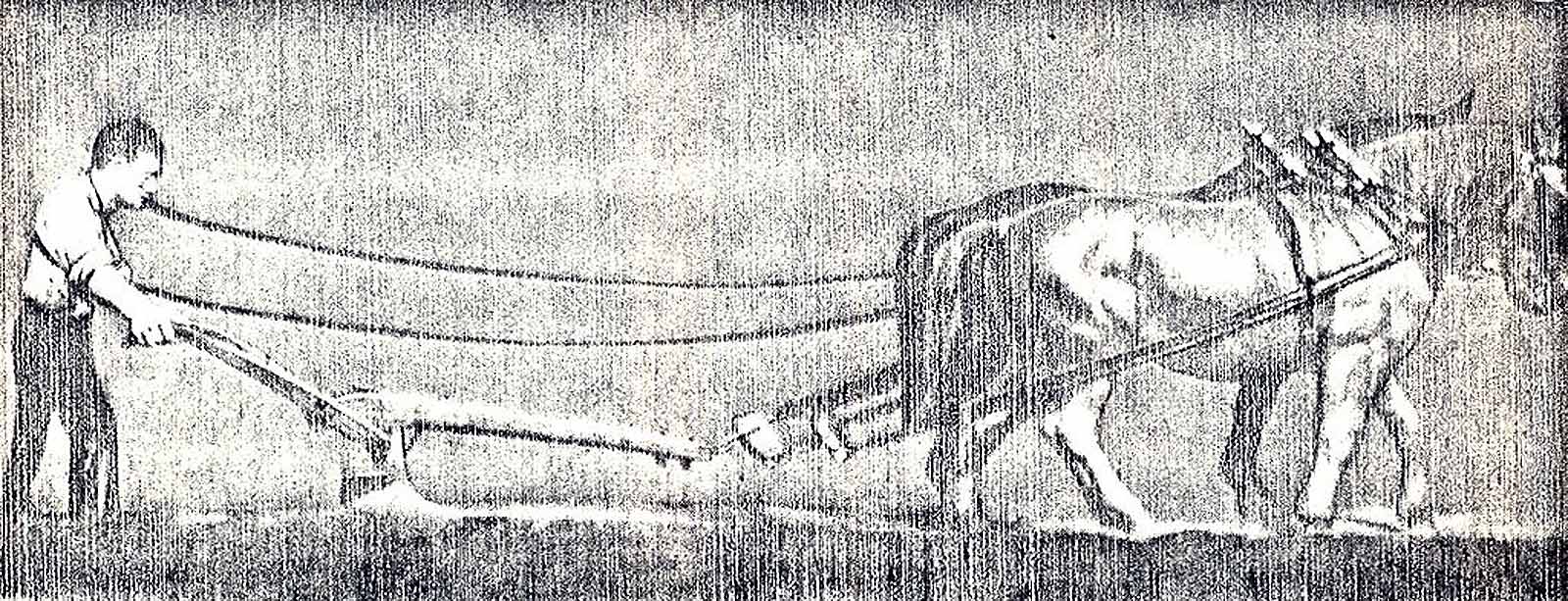
Notice that the plow threw the dirt in one direction only. Also note that the near horse in walking in the furrow previously made by the plow as the outfit goes around and around the field. In extremely rocky soil it is difficult to keep the plow in the ground and on occasions it became necessary for another to take the driving lines and stand on the double-tree to keep the point of the plow-share in the ground. A problem that always remains after a field has been plowed is that the last furrow plowed at the center of the field remains unfilled or what we used to call a 'dead furrow' and when irrigating alter the water runs to the hole, thus creating a problem.
The first riding plow also had a one-way plow only which didn't appear on the market until about 1912 which wasn't in time for Grandpa Wilkes. Uncle Ed and Uncle Noen may have farmed until about its introduction - particularly, Uncle Ed.
Following the plowing and harrowing, the latter a piece of equipment with a wood or steel frame with steel teeth about six inches long below the frame which 'scratched' the soil to prepare a better seed bed. The usual and better practice was to haul the rock that had been worked to the surface off the field. This was always a monotonous and a tiring job, especially for children old enough to pick up rocks from the ground and throw onto the wagon, but not sufficiently of age to handle a six-tined fork. This saved stooping so much.
If the plot of ground was not overly rocky the next step to prepare the seed-bed was to use a leveler - a home-made gadget built with heavy 2 x 8 or 2 x 10 inch plank on edge with perhaps three or four coarse pieces which would scrape the high places down and fill the low places. This made it much easier for directing the water at irrigating time.
Grain seed, such as oats and barley, was broadcast by hand-throwing prior to the using of mechanical grain-drills. The use of such equipment was later than Grandpa's farming years and by more affluent farming practices. The writer remembers well my father, each planting time, taking the back seat out of our white top buggy such as the one shown below and emptying two or three hundred pounds of seed grain in the bottom of the buggy bed and, kneeling facing the back, with the seed in front of him, and throwing or broadcasting it to the back and to both sides out from the buggy about ten feet while mother, and after we children became old enough to drive, take our turn. The secret was for the horses to travel in a straight path and to stay the proper distance from the last trip across the field. At each end of the field, Dad would mark a post or designate it in some manner, for the driver to go directly toward the post keeping it in line with some landscape mark or other object still further away. As can be imagined, it was not at all impossible for the driver to get lined up with a moving object such as a distant moving horse or cow, but this didn't happen often.
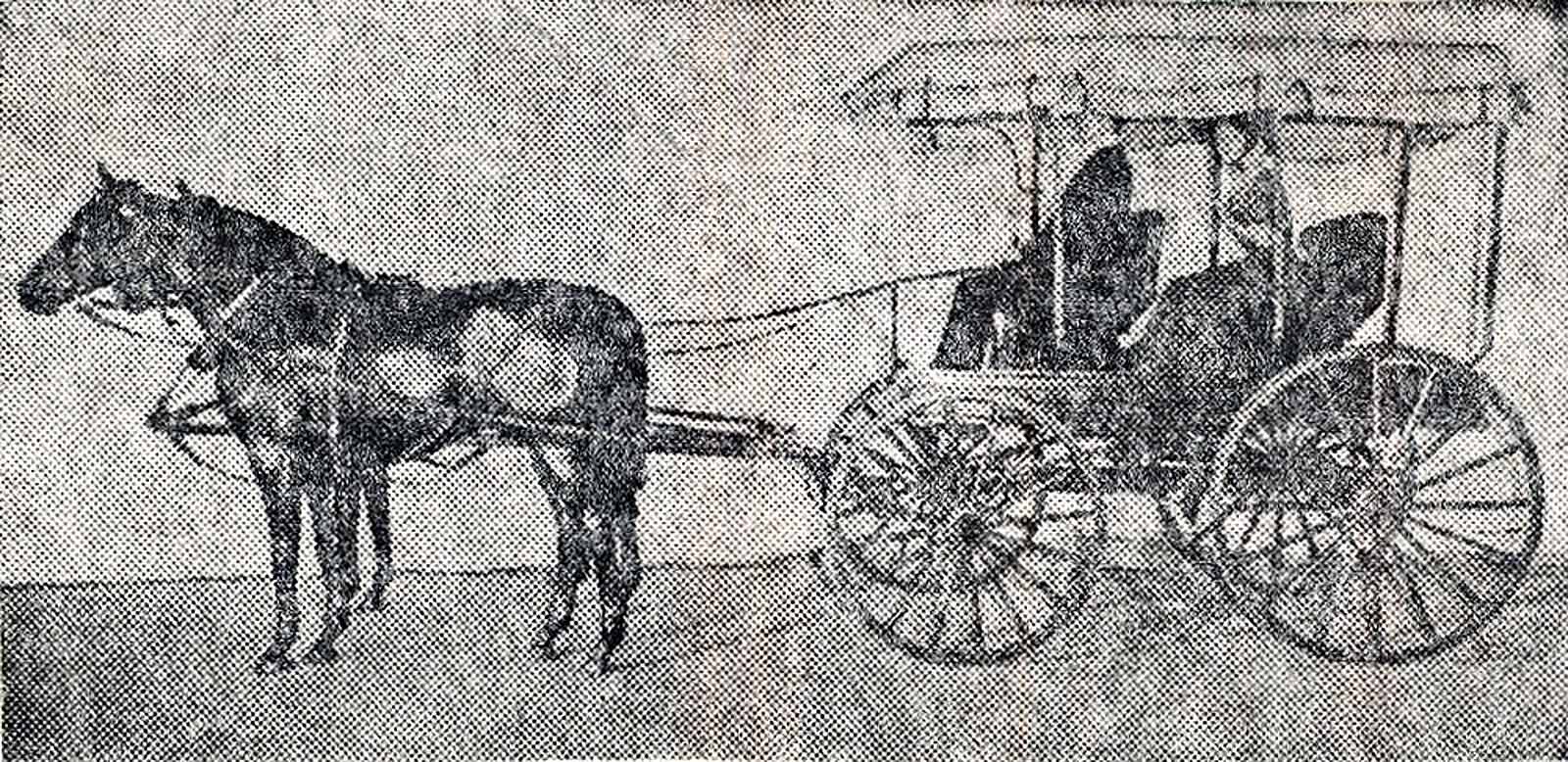
The above white-top, two horse, buggy is identical to the buggy the writer's family had in Star Valley during the last half of the first decade and all of the second decade of the 1900s. Note the rolled-up side and back curtains which could be lowered in storm weather. The longest trip I remember the family taking in this buggy was about 1912 or 13 when Dad and Mother and three, perhaps four of us children traveled to St. Charles to visit Grandpa Wilkes' sister, Aunt Sarah Ann Allred and other relatives. A never to be forgotten experience and we were riding in style. Our horses were white, however.
Now to another phase of everyday living relating to the John Wilkes family. Store-boughten clothing, during the 1880s and 1890s, and even into the first decade of the nineteen hundreds was a rarity, particularly in rural communities. At the time we are considering - the 1890's - bolts of cloth were being stocked by the merchants in Afton but, really, most of the family's wearing apparel was home-made and it was essential that the wife and older daughters become apt seamstresses. The days of the spinning wheel were long past. The home manufacturing of threads and yarns were a generation or two earlier. It is a fact, however, that tradition in the Wilkes family has it that some wearing apparel was actually made from deer skins and, certainly, beautiful living room and bedroom rugs were made from bear and other animal skins for their home.
During the earlier decades of living in Star Valley, the only method of washing clothes was with the galvanized tub sitting on a box or chairs, with what was called the scrubbing board over which, the soiled clothing would be manually rubbed back and forth. The water would be heated, usually in a copper boiler on a wood burning stove. The water had been carried to the house from a ditch in buckets, and following each washing cycle - usually the wash and then the rinse - would be manually carried a distance from the house to avoid tracking the mud into the house. Each Monday became the usual washday of the week and to most members of the family, it was looked forward to like a plague, for washing took priority so far as the house was concerned. Mealtimes on those days were usually simple, for the stove top was fully occupied with a boiler and other pots of steaming water. The homemade soap as it was dissolved in the hot water had an odor of its own, plus a limited sprinkling of lye into the boiling clothes created an atmosphere worthy of writing home about.
One of the phases of washing was the exertion of those doing the washing by hand wringing the clothes to a degree of dryness, especially the heavier articles. With the hands already tender from the rubbing on the scrubbing board - sometimes to the point of being raw and bleeding and, having been tenderized by the strong lye-water - the wringing of the clothes became a chore. The women folk usually did the washing and all too often their wrists were not sufficiently strong to endure the wringing process. Two or three decades passed in Star Valley before the mechanical hand-operated wringer with two rubber rollers came into use. It was clamped onto the side of the tub with the excess water running back into the tub. From the first wringing, the clothes would be placed into a rinse tub, sometimes scrubbed again and then re-wrung and then taken to the clothesline in the yard to dry. Oft times, due to shortage of lines, the coarser clothes would be hung carefully along a barbed-wire fence. This washing-day process was for winter as well as summer and cold winter days only added to the misery of the occasion, from the breaking of the ice at the water hole in the ditch to get the water for the washing process, to the hanging of the clothes in the raw air of the out-of-doors. On occasions, particularly during winter time, to add to the already dreariness of washday, the more fragile or more readily needed clothing was hung about the house to dry. What a relief it became to the whole family when Monday's wash had been completed. This writer spent several of his younger years experiencing the above story because I was there.
The above story is meant to relate to Grandma Wilkes and her washdays and they weren't for only the younger portion of her life. These were the type of washdays for the entirety of her life - all 58 years.
By the time she passed away - 1915 - it is possible a crude type of washing machine may have been on the market. It well remember - probably as early as about 1912 - our new washer which replaced the washboard - at first only partially, for Mother never felt some of the clothes were really clean unless she finalized the wash by running them over the washboard. The new washer was on legs with castors and with a wooden tub. Thru the lid was extended a wooden spindle on the under end of which was attached three or four wooden sprockets which resembled somewhat short legs of a stool. When the lid of the washer was down these sprockets engaged themselves in the clothes in the water. On the top surface of the lid there was a combination of metal gears which enmeshed into each other so when the wooden handle, like a 24 inch portion of a shovel handle, which extended above the washer, was pushed back and forth, the gears would turn the spindle extending thru the lid and, in turn, the sprockets extending into the clothes would swish the clothes back and forth thru the water. After five or six minutes pushing the handle back and forth, the clothes, providing they weren't overly soiled, and providing the water was hot and tempered with the proper proportion of hand-made soap and lye, etc, the clothes were ready to be run thru the wringer, also attached to the wooden tub, and would be directed into a nearby galvanized tub with clean rinse-water. The clothes would be swirled about in the rinse-water by hand and, providing the scrubbing board was not needed, the clothes would be returned thru the wringer and caught by hand and placed in another pan for taking to the line for drying.
We mustn't overlook the fact that in cold winter weather, after being taken from the outside line, the clothes would be carried back into the house as large and in the shape they were when on the line and as stiff as boards. The new washing machine became a great blessing. Subsequently, small gas engines were designed to supply the power to run washing machines and still later, electric motors. These were just beginning to show up when Grandma passed away.
During the lifetime of Grandma Wilkes - at least most of it - kerosene lamps and lanterns were the only source of night-time lighting. Afton was fortunate in have close water power in the rapids of Swift Creek for its progressive townspeople installed electric generators to provide local electricity for, at least, electric lights within the town limits. It is possible this came as early as 1907 or 1908. Undoubtedly, Grandma benefited from this town-wide innovation during her last four or five years, but its use was undoubtedly confined to the simple light bulb.
Very early models of cars were currently country-wide, but Star Valley was so isolated, and with its rough rocky roads, few had made an appearance by 1912-13. It is possible Grandma Wilkes may have experienced a ride in one, but certainly they never owned one before she passed away. Cars were very much a novelty up to the time of her passing, for this writer well remembers when in the lower grades, the teacher would invite the class to the window when she saw one nearing the school house, this around 1913 or 1914.
Grandma Wilkes was considerably ahead of modern-day appliances such as the refrigerator, electric irons, electric cooking stoves or heaters, and had probably never have dreamed of such then unheard of radio or television sets. The technological world of today was just getting ready to bud open when she left us. Her life was a life of hardship to the very end. In the case of Grandpa Wilkes who lived some 13 years beyond her passing, he did get to see a few of the new inventions which changed our lifestyle, but even at the time of his passing away in 1928, it was far from what it is today.
As explained earlier, the Wilkes family moved to their farm west of Afton to a nice home on Main Street. Farming never appealed to Grandpa, probably mostly due to his physical handicaps, but none of us can deny but that homestead on which they moved in about 1887 or 88 proved to be a stepping-stone financially by the mid 1890s when they became able to purchase five acres in town, and also, nearly 190 acres to the north of Swift Creek. It appears they purchased this last farm mainly for investment purposes.
About the time of their moving to town, Grandpa obtained employment, as has previously been mentioned, with the newly established Burton Brothers Mercantile business which was located immediately across the street from their new home. He was an enterprising businessman himself and sought for and obtained the contract for the U.S. mail route from Afton to the Lower Valley. Responsibility for this project was pretty much turned to son, Ed. Reportedly, they held this contract for eight years.
Also, according to his daughter, Aunt Mabel, her father became one of the first, if not the first, postmaster in Afton. Whether this was in conjunction with his employment at Burtons we do not know. He was highly thought of as is apparent from the fact that he served two terms as district commissioner, this according to Aunt Mabel's history of her father. He was also the water commissioner in Afton for a period of three terms.
The prospects for the Wilkes family, from our vantage point, must have appeared to them as very good. It appears they were now merging to a period of financial security. His holdings and employment prospects were in his favor, but a dark shadow appears to have been lurking in the background. Undoubtedly it didn't make its appearance over night. Surely, Grandma Wilkes and the family had seen it coming - perhaps for years and maybe, from the beginning.
This writer has known of this 'dark shadow' since I was a small boy and now that I have come to the point of writing of the family history, the question arises as to whether the full history should be related or whether a portion of it should be left unwritten. After much thought, I have concluded there to be an important lesson to be learned from Grandpa Wilkes' example and, knowing him as I do, I don't think he would object to sharing a lesson which became costly to him and his family. The great lesson in it is the fact that he had the strength and fortitude to overcome.
It appears alcoholism with Grandpa Wilkes may have been becoming a problem about the time of the business ventures described earlier when they sold their farm west of Afton and purchased the five acres in town and the 189 acre farm joining Afton on the north. The deeds indicate no encumbrances on the real estate. The construction of the house in town appears to have been previous to the purchase of the last farm which all indicates its cost was under control, if not entirely paid for.
As indicated, there appeared steady employment possibilities. Burton's store, the post-mast position and the mail contract to the Lower Valley. These conditions were on-going about the time of Aunt Mabel's birth. Her reports are from what she remembers the accounts as told her by family members.
Let us reflect for a moment. The reader may reflect to the St. Charles' 1870 Census which reveals that John Wilkes' father, William, stated that his occupation was that of a 'brewer'. John was listed as the only child at home with his parents and was then 18 years of age.
If John's father was 'dabbling' with brewers yeast, could it have been possible that far back, that John had acquired 'a taste' for the concoction? This, coupled with his physical handicaps may have provided for him a false sense of ability and security. Discouragement and depression became fertile ground for the disease of alcoholism and despite the brighter prospects showing up by the middle of the 1890s and the early 1900s in Afton of which we have been referring, all in favor for a bright future for the Wilkes family yet, the evils of 'the drink' began to show its ugly head. Grandpa Wilkes gradually became the victim. The bright prospects for the family grew dimmer and dimmer as Grandpa John, little by little, found his ability of hold positions of trust with those who had once hired him were fast waning until such prospects became practically nil.
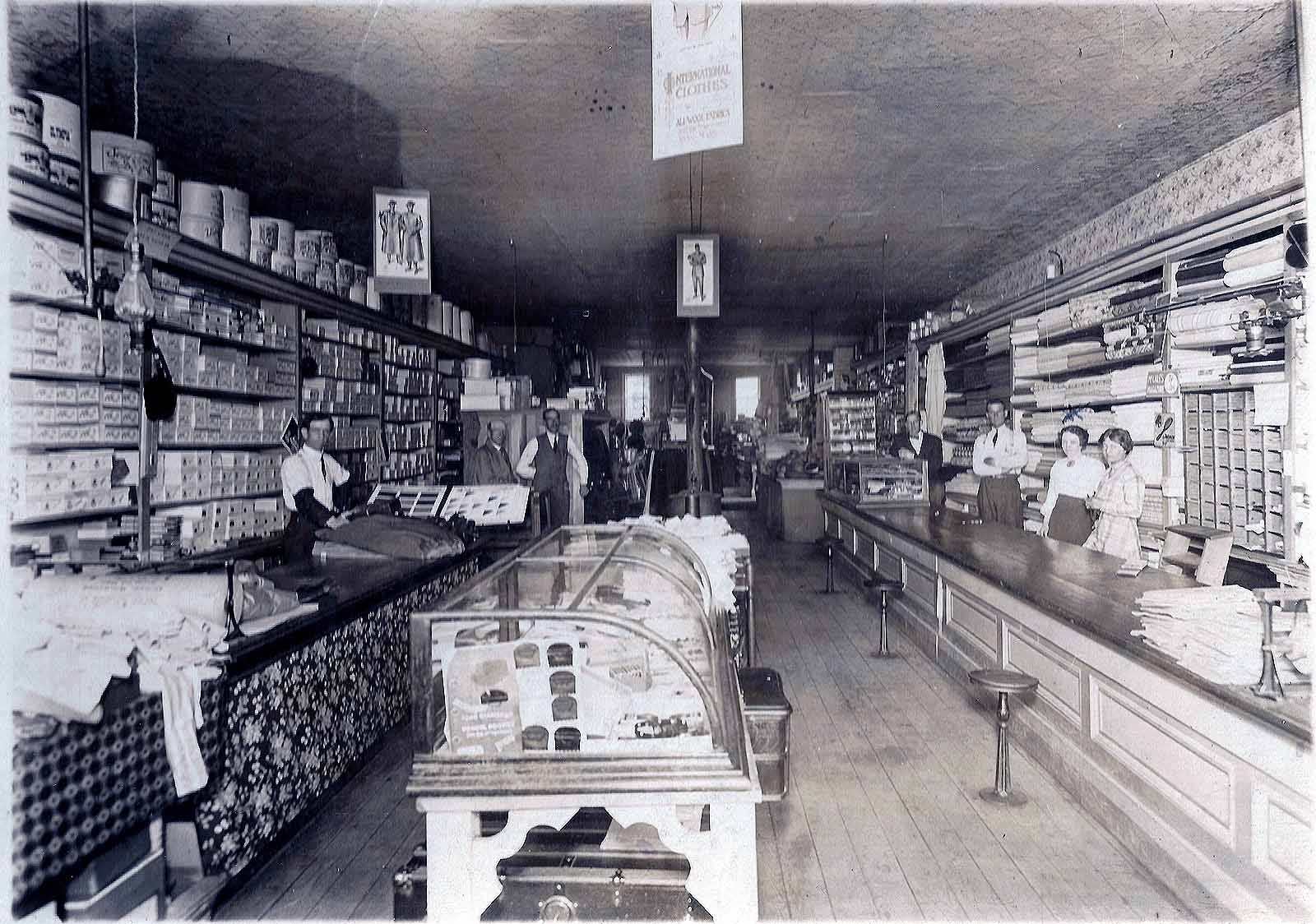 The above picture is the interior of the dry-goods department of the Burton Brothers' Mercantile probably betwween 1912 and 1915. The grocery department could be reached toward the back and thru a walk-way thru the wall on the left. There was a main door to the boardwalk from each department. Aunt Luella is the lady in a black skirt, second from the right. In 1917, this writer purchased a birthday pin for his mother. Aunt Luella waited on me, and she took it from the glass-top front-center case. I paid her the big sum of $2.00 by my personal check -- the first check I ever wrote.
The above picture is the interior of the dry-goods department of the Burton Brothers' Mercantile probably betwween 1912 and 1915. The grocery department could be reached toward the back and thru a walk-way thru the wall on the left. There was a main door to the boardwalk from each department. Aunt Luella is the lady in a black skirt, second from the right. In 1917, this writer purchased a birthday pin for his mother. Aunt Luella waited on me, and she took it from the glass-top front-center case. I paid her the big sum of $2.00 by my personal check -- the first check I ever wrote.
 Afton Main street looking north from the Star Hotel on the left. Burtons is the further of the four buildings on the right. Directly across the street to the left, is the John Wilke's residence, which cannot be seen from this angle. The date of this picture is September, 12, 1915.
Afton Main street looking north from the Star Hotel on the left. Burtons is the further of the four buildings on the right. Directly across the street to the left, is the John Wilke's residence, which cannot be seen from this angle. The date of this picture is September, 12, 1915.
At the very time the family was undergoing this concern, an additional sorrow came to the Wilkes family on the 9th of January 0f 1899 when little daughter and sister, Nettie Viola, who had just celebrated her fifth birthday a little over two weeks before, passed away at her parents' home in Afton. We know of no record announcing the cause of her passing but, nevertheless, her leaving would have 'hurt' for a five year old would have been with the family sufficiently long as to have entwined her love and companionship into the hearts of her parents and brothers and sisters. Her burial was one of mid-winter and, in Afton, the ground would have been covered with snow and graves which, even in summer time, would have been difficult to dig by hand, were now even more difficult due to the, not only rocky, but also frozen conditions. The church house in which the funeral service would have been held was slightly more than a block away from the home and, from there, another approximately six blocks to the cemetery where her little body and casket were laid to rest. (See map of Afton on page 211) Probably, on many a summer evening, walking excursions on the part of the family were taken to visit the little grave for the members of this family loved that little girl.
Seven and one-half months later, as though the Lord gave second thought to His taking Nettie away, another little girl came into the home. On the 25th of August of the same year - 1899 - baby Mabel arrived which had to have been a joyful occasion. There was a super-abundance of love in the Wilkes' home and it was thoroughly shared.
Let us briefly return to other evens which transpired with the family and of which previous mention should have been made. Second child, but eldest daughter of Grandpa and Grandma Wilkes, Mattie, had married as early as 1892 and before the year 1900 she had three children and, so far as can be determined, had moved to Rockland, Idaho, but had returned to Afton, at least before the birth of their fourth, Frank, was born 1 April 1900. Aunt Mat's and Uncle Low's first-born, Lavina, who was born 5 Dec 1893, passed away on the 28th of September 1896 - the first of the Wilkes' related family to have been buried I Afton - and as can be observed, nearly three years prior to Nettie.
Eldest son Johnny, had married Luella Child on the 18th of October 1895, when he was 21. Following the winter in Afton the young couple moved to Thayne in the Lower Valley where he was appointed postmaster and was also hired to serve as manager of the mercantile business owned by the Roberts Brothers. Apparently he had worked for the parent company in Afton. By the time of the birth of their first child, Edgar, on the 30th of January 1899, three weeks following the death of five year old Nettie mentioned above, the young couple had returned to Afton due to the Roberts' Brothers dissolving the Thayne store from the Afton store, whether by sale to another, we don't know.
Grandma Wilkes was now facing what proved to be hard years. Her husband's income was becoming greatly affected due to the lack of steady employment. We simple do not know the full story. Living at home was Uncle Ed, age 20 with the mail contract - at least assisting with it - to the Lower Valley; Aunt Lottie, age 17 just past, Hettie, nearly 16, Uncle Noen, 13 1/2, Lola 9 1/2 and newly-born, Aunt Mabel.
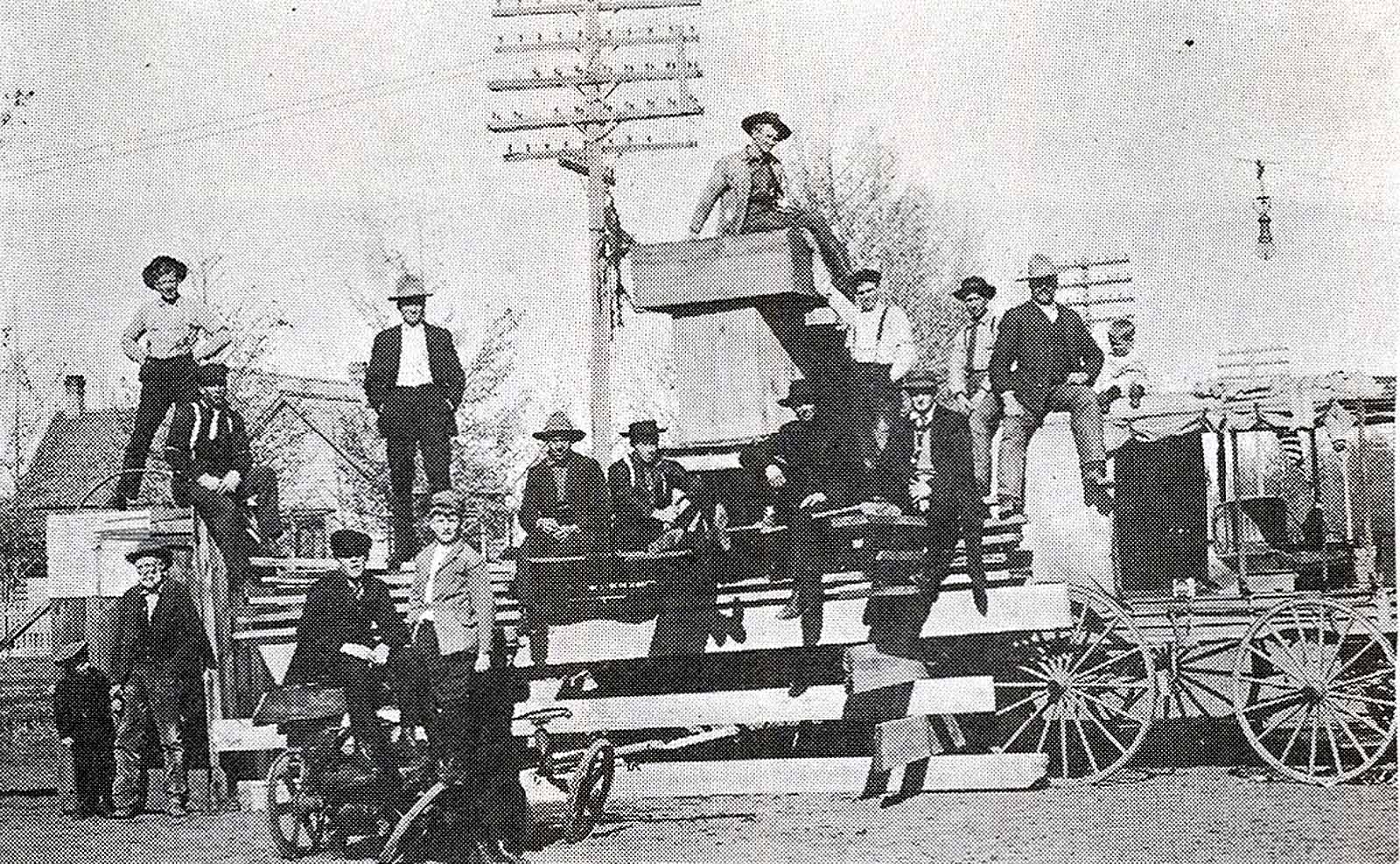 Yesteryear's Halloween pranksters had fun blocking Main street with all that wasn't tied down, such as this picture shows, apparently, also, to the delight of the city fathers. Roe Hale, the Marshall, is sitting at the top of the white-top buggy. Note the riding sulky plow in front. See Grandpa John Wilkes with grandson, DeLoyd Wilkes, by his side in the bottom left corner. Could it have been Grandpa's little outhouse directly behind him, on which a man is standing and another sitting? The Wilkes' town home shows thru, directly behind them. Burton's store would be on the near side of the street in front of the white-top buggy, but not shown. This picture couldn't have been later than about 1910. DeLoyd, shown in the picture, passed away in April of 1913, at the age of ten.
Yesteryear's Halloween pranksters had fun blocking Main street with all that wasn't tied down, such as this picture shows, apparently, also, to the delight of the city fathers. Roe Hale, the Marshall, is sitting at the top of the white-top buggy. Note the riding sulky plow in front. See Grandpa John Wilkes with grandson, DeLoyd Wilkes, by his side in the bottom left corner. Could it have been Grandpa's little outhouse directly behind him, on which a man is standing and another sitting? The Wilkes' town home shows thru, directly behind them. Burton's store would be on the near side of the street in front of the white-top buggy, but not shown. This picture couldn't have been later than about 1910. DeLoyd, shown in the picture, passed away in April of 1913, at the age of ten.
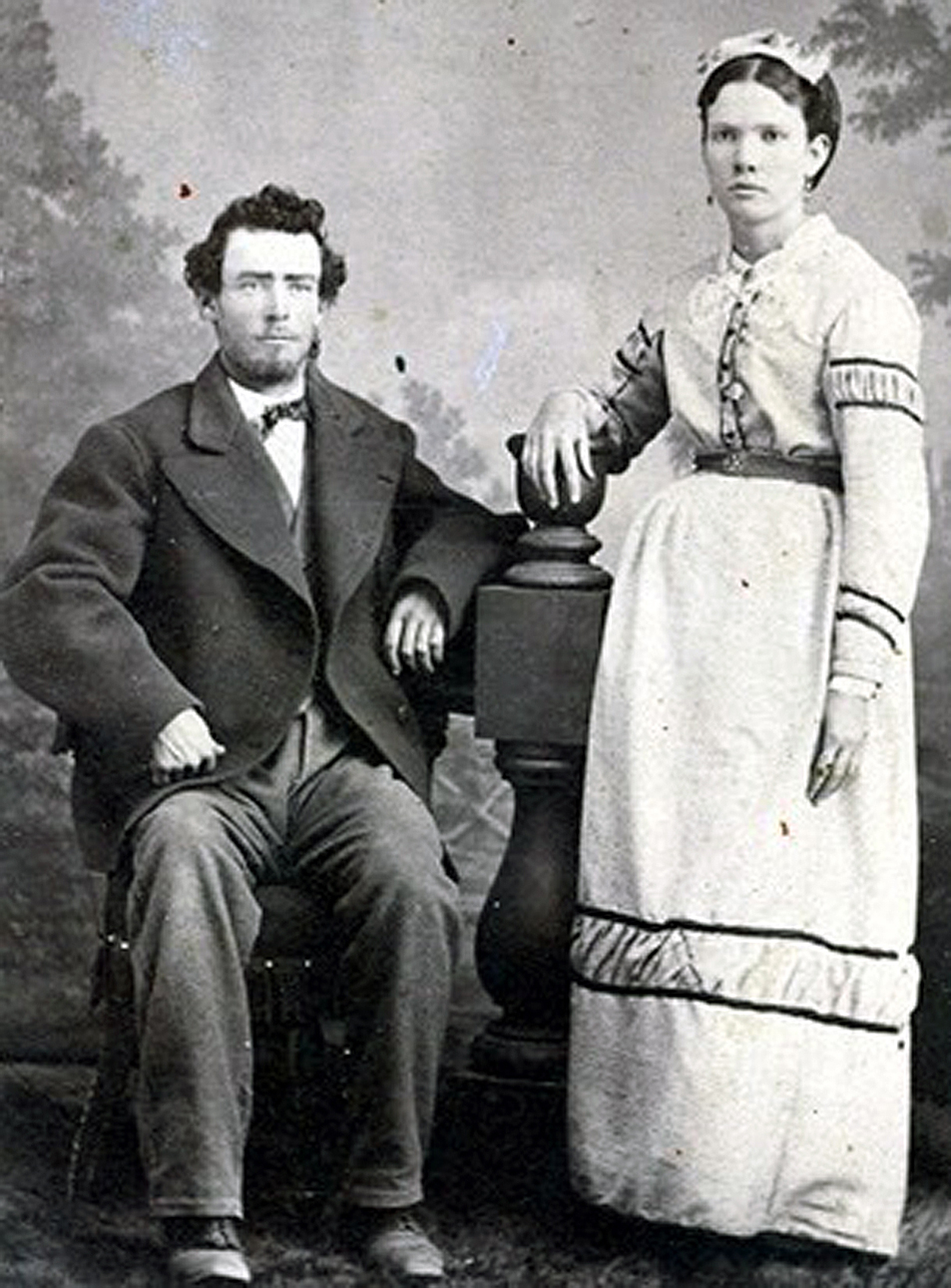 John and Martha Wilkes' supposed wedding picture, or soon thereafter. They were
married in October of 1873.
John and Martha Wilkes' supposed wedding picture, or soon thereafter. They were
married in October of 1873.
 We have no history of the construction of this schoolhouse -- undoubtedly not
the first, but it was early, probably as early as 1900. It is understood Aunt
Mabel Wilkes Brown attended here, as did many of us grandchildren of Grandpa
and Grandma Wilkes. We have no picture of the ward chapel, which was down the
street to the school's left one half block. Note the beautiful stone stake tabernacle.
We have no history of the construction of this schoolhouse -- undoubtedly not
the first, but it was early, probably as early as 1900. It is understood Aunt
Mabel Wilkes Brown attended here, as did many of us grandchildren of Grandpa
and Grandma Wilkes. We have no picture of the ward chapel, which was down the
street to the school's left one half block. Note the beautiful stone stake tabernacle.
Enterprising Grandma saw the handwriting on the wall. Her husband was sick, seriously sick, but she knew her children would give her their full support. It was up to her to now keep 'soul and body' alive, family-wise. The family was using all the house, but in counsel with them, they concluded that their home was in a prime location to accommodate 'boarders'. There was, as yet, no hotel in town and visitors in the Valley needed accommodations.
To make a long story brief, it can be reported that Grandma Wilkes became a successful boarding house operator and for several years she had rooms and three meals a day for those wishing such services. This required the children to join together in a limited number of rooms. The privacy of a home had to be sacrificed for three or more rooms had to be given up for their money-making enterprise. There were single men who had come into the Valley with the Forestry Department who would be in town for, perhaps, months at a time. It was to this type clientele Grandma catered to and, for the most part, got. She became selective and was able to keep the choice of them, but the family lost the freedom of family life. Grandma found it was possible to carry on such a business due to the fact that she had helpful daughters and, at the time, Lottie and Hettie were her mainstays, but this work deprived the two girls of their schooling. Every day the rooms had to be prepared for their guests and cooking meals was a full-time job - it was all hard work and menial. In order to provide two, three or four bedrooms each night for their guests, it often became necessary for the children to give up their rooms and crowd themselves together, oft times, even in the living room. It was not easy and it was for several years.
In an hour - or longer - taped interview with Uncle Lorain and Aunt Mabel Brown at their home in Logan, Utah, on the 15th of May 1965, this writer with his wife, Mabel, were informed by Aunt Mabel that she remembers very well of accompanying her mother when she, Aunt Mabel, was but a little girl, to the grocery stores in search of good buys for food for the boarding house. She relates how the care of the boarding house was almost a 24 hour job and how exhausted her mother would become some days. This was likewise true of the girls who were helping and Aunt Mabel mentioned what a struggle it was to make ends meet and that her mother would not trust the younger girls, especially such as she, to do the cooking for they couldn't afford to have a mishap and spoil a single bit of food.
She mentioned, but in a non-critical way, that very often her father would return home - sometimes daytime, sometimes nighttime - so intoxicated that the family and/or friends had to put him to bed and, at times, even had to go to the town pool hall in order to take him home. The children were taught by their mother not to criticize or demean their father for it was a disease from which he was suffering and, for which he was not wholly responsible.
Two or three years passed in the above fashion. The Wilkes children were maturing and were as normal as any maturing person in that, they too, sought lifetime companions. Interestingly, two succumbed of the Wilkes family at a single stroke. Son Ed and daughter Hettie had experiences which went something like the following: A mining camp family moved into Star Valley from Almy, Wyoming, having purchased a farm down on Salt River, but two miles further north than the John Wilkes' farmstead earlier described. The year of their arrival was 1896 - the 10th day of April to be exact.
One of the Blacker daughters, Mary, did not move with the rest of the family, but seemingly was assigned to remain in Almy to assist in the care of her grandparents whose health was not the best, particularly, her grandmother on her mother's side whose name was Mary Danks Loveday and after, whom, daughter Mary, was named. Upon the grandmother's passing away in April of 1902 in Almy, Mary now 24 years of age and unmarried, was at liberty to rejoin her family who had remained down on the farm in their muchly overcrowded log house. In the meantime, the Wilkes' daughter, Hettie, was, on occasion being seen by a Blacker son, Thomas, but known as Tom. He was but a year and a month younger than his sister, Mary.
It could have been a surprise to Grandpa and Grandma Wilkes, but maybe not. They could see what was going on but, at any rate, a double wedding took place in the Logan Temple on the 10th of June 1903, when Ed Wilkes and Mary Blacker and Thomas Blacker and Hettie Wilkes were married.
Uncle Ed and Aunt Mary were fortunate in that they had a home to return to for his parents had purchased the old Dakin 189 acre farm a few years before as an investment on which was a three room log house situated immediately north of the Swift Creek bridge just as one left Afton toward Grover. Undoubtedly Uncle Ed had been operating this farm prior to their marriage and, so we suspect, had his own team of horses, probably a wagon and sleigh for, as we remember, he had been hauling mail for a few years to the Lower Valley and it was quite possible he was still engaged in this activity.
Tom and Hettie had no family home to return to, however, undoubtedly, he had made arrangements for a two-room log house near his parent's home. Tom, apparently, had had employment on the Burton Ranch just across Salt River from his parent's home. If he didn't have work there he soon obtained employment on the Burton ranch and subsequently they moved on it where they lived for a couple of years. About two years later they purchased 40 acres on the Afton-Grover road two miles north of Afton where they lived until 1920 and then moved to Idaho.
With two of the Wilkes family leaving to be married, as described above, must have had an effect on the rest of the household. Remember, it was this very time that the Wilkes' Boarding House or Cottage Hotel, as someone has reported it was called, was looking for more room for their prospective boarders. But, also, it was this same time the establishment was needing good help to keep things going. The business continued, nevertheless.
Family tradition has it that during these early years of the 1900s the family experienced continued poverty. Be it known, however, that every Star Valley family was enduring that same poverty. May it be suggested that the reader review the Blacker Family History by this same writer if one wishes a lesson in poverty.
It was, indeed, a very sad day when on the 11th of March 1905 the Grim Reaper made his appearance again to the John Wilkes family. This time, instead of the children, it was their eldest married son, Johnny. This proved a shock to the family and the community. As stated earlier they had returned to Afton from Thayne where, we understand, he continued working in the Roberts' Brothers store. Seemingly, it was a quick case of pneumonia.
He and Aunt Luella had been blessed with three children, Edgar, born the 30th of January 1899, DeLoyd, born 12 April 1903; and baby, Norma, born 12th of February 1905 and who was less than one month old when her father passed away. Aunt Luella, now a widow with three small children, when but 31 years of age.
As the months passed, following the funeral of her husband, Aunt Luella, naturally, had to find means of providing for her children which she did. How early in her saleslady's career she started with the Burton store, we do not know. From the writer's personal experience, I am aware that she served with Burton Brothers for many years as a general sales lady and, particularly in the dry goods department. Whether she started in this business immediately following Uncle Johnny's passing away is not certain.
Just where she and Uncle Johnny had lived in Afton we are not aware, but Grandpa and Grandma Wilkes, with their two city lots, #1 and #2 of Block 19, proposed to the young widowed mother that they sell her Lot #2 - see map on page 211 - on which she could build a home and be close to their home. This she did and it can been seen from the map that her house was constructed just a half block from the Wilkes' home and less than a block from Burton's store which was located on Lot #2 of Block 20.
Let us hold in abeyance momentarily the transfer of Aunt Luella's newly acquired Lot #2: At the same time as this transaction was being death with, it appears Grandma Wilkes had convinced her husband that they should take steps to protect herself from any chance of losing her home, should the occasion arise when he was not sober from alcoholic influences or, perhaps, becoming indebted to others, or, perhaps, he, unwisely disposing of his home. Such things have been done by drinkers, even, to their own surprise when they become sober.
Note the legal transaction:
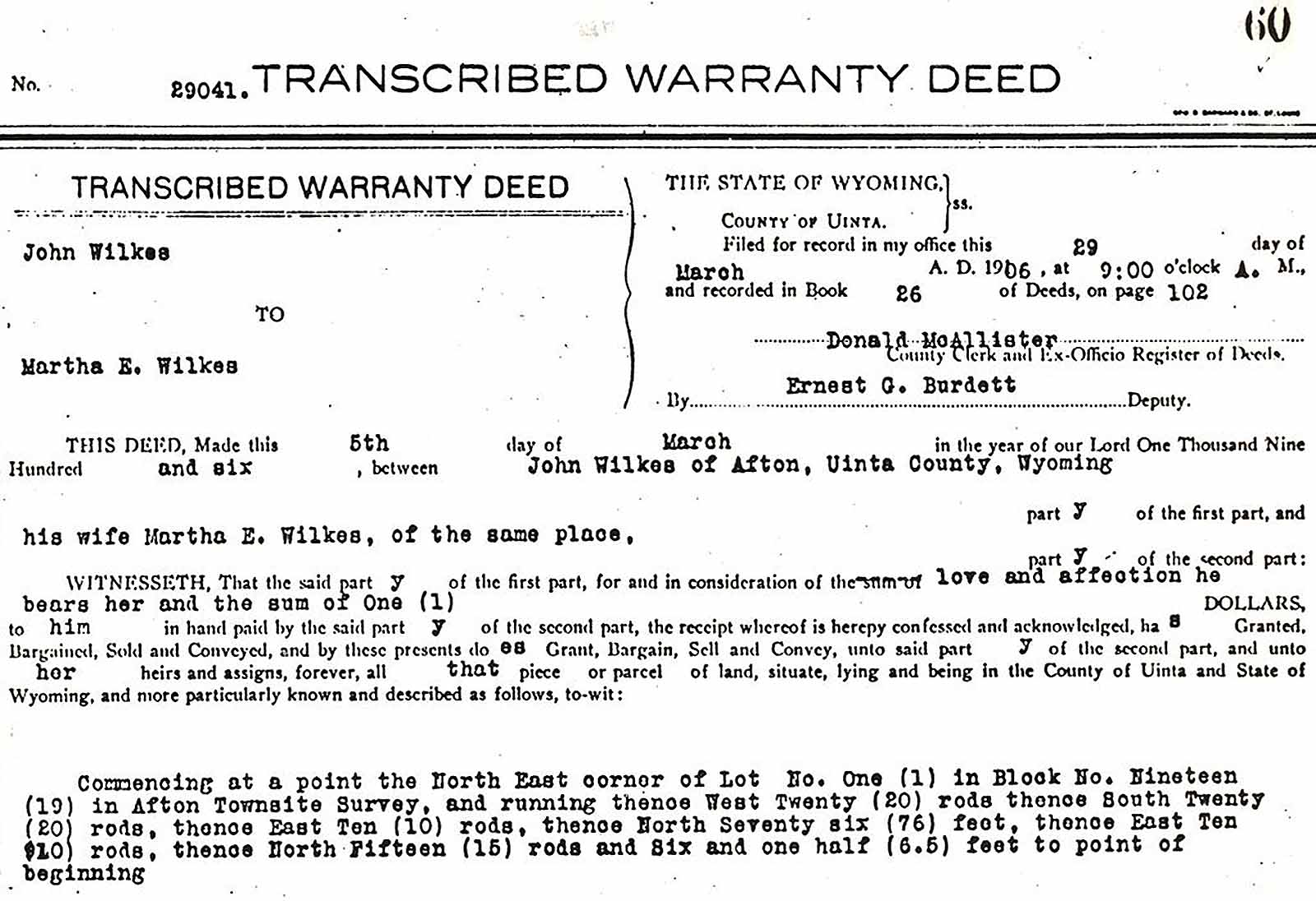
It appears Grandma and the family felt that title to Lot #1 should, at this time, be transferred from the name of John Wilkes to Martha Wilkes. We don't know that it would ever have gotten into other's hands, but wisdom dictated that the transfer be made. It may have been as much a suggestion on the part of Grandpa Wilkes in his sober moments as it was Grandma's or others.
Did you note the price of transaction? "For and in consideration of the love and affection he bears her and the sum of One (1) Dollar".
Note below the transfer of Lot #2 from John Wilkes to Luella Wilkes. In the interest of space in this history, only the first portions of these Deeds have been copied here:
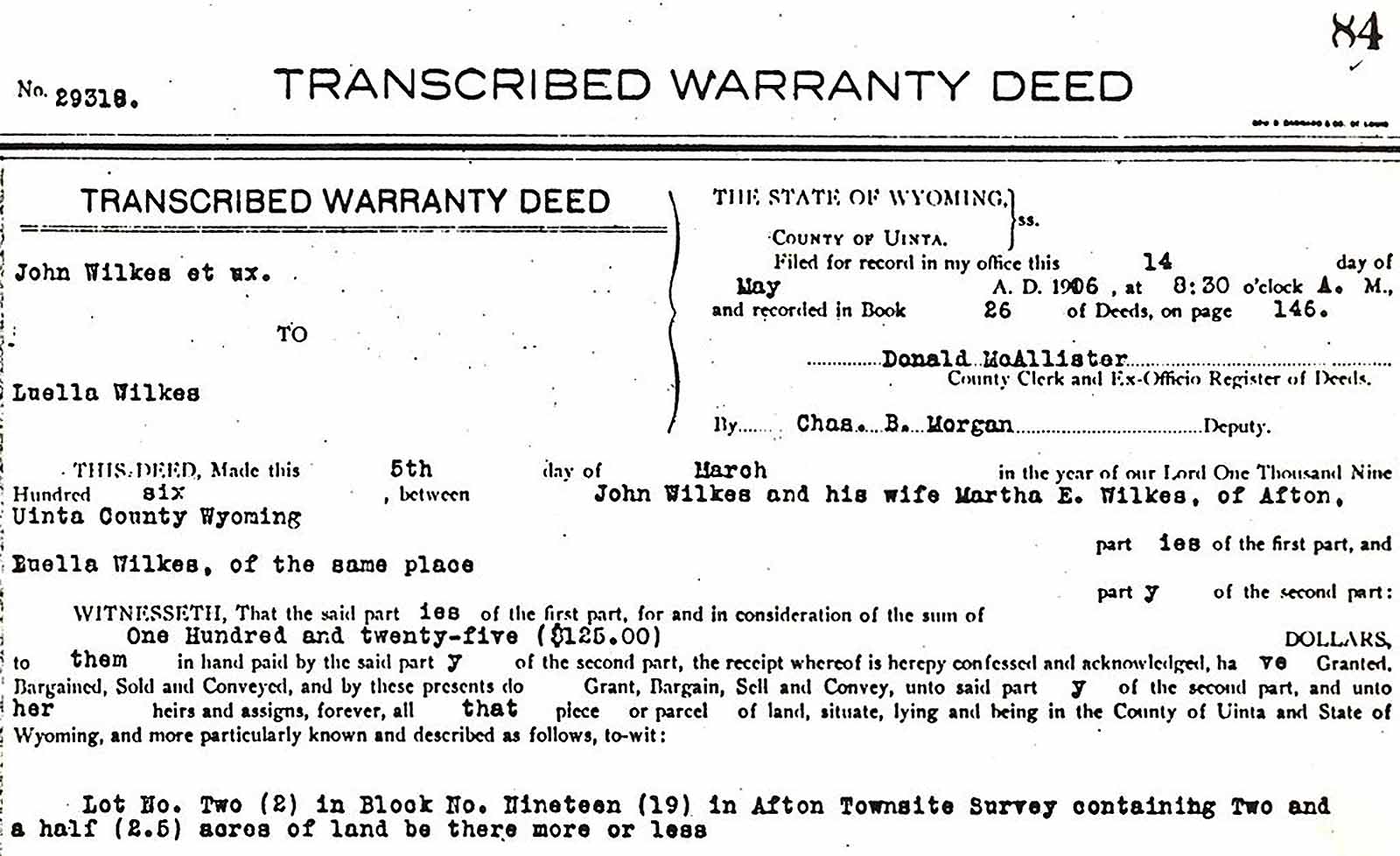
Those of us who have had long acquaintances with the children of Grandpa and Grandma Wilkes are aware of the closeness and concern and love each had for others of their family. They had love and concern for all people. One instance comes to mind and from good authority. It is that daughters Lottie and Hettie were girls of nearest ages and they came very close and dear to each other. Tradition has it that as they reached partying age or age for dances or whatever the social function, it was quite often, during the years of about the turn of the century, necessary for them to so schedule their going-out activities in order to wear the one 'going out' dress they had between them.
It so happened that sister, Hettie, the younger of the two, married first. This writer, after over eighty years subsequent to the occasions, hopes that his mother, Hettie, did not deprive Aunt Lottie of many dating privileges. I suspect not many. I am sure Aunt Lottie didn't deprive Mother of many, either. Neither of them were that type of person and that can be said of all the children of Grandpa and Grandma Wilkes. They were all good, genuine, caring people who were richly endowed with the image of the Master when he said, "Do unto others as you would have them do unto you". I say this, not that they were linked into my ancestry, but because it was a fact. Indeed, they were a 'breed apart'.
We are not aware that Aunt Lottie delayed her marriage simply because her sister, Hettie, married earlier. It may have been in her reasoning that she should remain at home to assist her mother until her still younger sister, Aunt Lola, grew another year older. She was then about ten years of age. Such would have been a gracious gesture, but it is not likely Grandma Wilkes would have expected her daughter to have so sacrificed to that extent. With all such possibilities, could it not have been that Aunt Lottie's intended companion had simply not shown up? We are aware that Uncle Hy Barker was born in St. Charles probably totally unacquainted with the girl he was going to marry. When he came into Star Valley, we do not know but, but come he did, and on the 28th of November 1904 the young couple were married.
Uncle Noen and Aunt Mamie were married on the 11th of October of 1905. The home nest was emptying rather quickly as marriages go as can be observed from the fact that between and including 1903 thru 1907 when Aunt Lola and Uncle Joe Holbrook were married on the 18th of December of that year, five of the Wilkes' children flew from the family nest which makes a good average of one per year. That was faster than the stork brought them in the first place. As the reader will recall, Nettie passed away when but five years of age back on the 9th of January 1899. Aunt Mabel, the youngest of the family was just past eight years of age when her next older sister, Aunt Lola, was married. She was to grow up for several years as an only child.
The entire John and Martha Wilkes family were quiet and unsophisticated, with little or no forwardness among the lot. In fact, if they had a fault, it could have been classified as shyness. There wasn't a one who would push himself or herself to the front, nor was there a noisy one amongst them. In short, here was a family who was the salt of the earth.
The entire family of father, mother, and nine children, all living to maturity but Nettie, proved to be a good pioneer family. They never lacked for sociability when to themselves, for they were a joy to each other. Their individual histories are quite universal in telling of the evenings spent at home together. Most of their personal histories report that they did considerable singing together. In their home, they had a foot-pedal organ and Hettie - and perhaps others - would chord and Uncle Ed would strum the guitar.
Mention has already been made of daughter-in-law, Luella, following the death of her husband, of purchasing lot #2 from Grandpa and Grandma and having a home built. For its day, it was a lovely two-storied structure, and she and the three children made of it one of the nicer homes of the community. Being a widow, it became necessary for Aunt Luella to work, and in due time, a young girl from Auburn, Ella Kenyon, when about twelve to fourteen, was offered a home and lived with Aunt Luella and took care of the children for several years during working hours. Ella remained with Aunt Luella until she married William Blacker on the 23rd of February of 1913.
Uncle Ed and Aunt Mary, following their marriage in 1903, had born to them their little daughter, Arvilla in 1905 and son, Howard, in 1907 and what a sad day it was on the 28th of October 1909 when Aunt Mary passed away leaving her sorrowing husband and their two young children, four and one-half and two and one-half years of age.
So far as Grandpa and grandma Wilkes were concerned, there was nothing for Uncle Ed and children to do but return to their home. It was a very difficult year for Uncle Ed, for he realized he was monopolizing board-house room, and was sensitive to the fact that Grandma Wilkes was crowded for time caring for the children. This condition, undoubtedly, brought serious reflection for Uncle Ed for he was singularly opposed to being a burden to his mother.
After eleven long and very lonely months, he started seeing and proposed marriage to a young lady of the community, yet unmarried and six months younger than Uncle Ed. She accepted with her willing consent to assist I the care of his two little children. Her name, Elizabeth "Bessie" Moffat, and what a special person she was. Their marriage took place on the 28th of September 1910 in the Salt Lake Temple. The exact date is not know, but in September one year later, a little baby, known on our records only as Baby Wilkes, was born, but passed away near birth.
Aunt Bessie proved a wonderful mother to Arvilla and Howard and, in time, Mary, Lahore and Murray came to bless their home. No brothers and sisters by the same parents became closer and more loving than Uncle Ed's children and to this day - 1984 - could anyone be more dear to each other.
The Grim Reaper was not to leave the overall-Wilkes family alone for long. This time, a repeat visit to Aunt Luella's family in their nice home neighboring to the John Wilkes' home. Just four more days, DeLoyd, child number two, would have been ten years old, became critically ill and passed away on the 8th of April 1913.
By 1915 the most of, if not all of, two decades passed during which time Grandma Wilkes and family were very much occupied with their "Cottage Hotel" or boarding house. She proved a good manager and good cook, but throughout most of those years, she carried the full responsibility and seldom had time to take a day from her work. Years earlier their daughters had been mainstays and greatly assister her, but by 1915 daughter, Hettie had been away twelve years, daughter Lottie, had been away eleven years and daughter Lola had been away from home for seven or eight years. At times, all of them would return to give her a hand, but she needed so much more help. Aunt Mabel was fifteen to sixteen years of age - just reaching an age where she would be of assistance.
Grandma's last sickness overtook her before the middle of January of 1915, a month and a half before she reached her 58th birthday. In our interview with Aunt Mabel in 1965, she related to us the occasion of the passing of her mother. Aunt Sarah Ann Allred, Grandpa Wilkes' sister of st. Charles, had been called to assist in Grandma's last sickness which was not of long duration. Aunt Mabel said she was not told much of her mother's condition - little girls were not told everything by adults - however, she could tell by the way the doctor and Aunt Sarah Ann conversed in whispers that things were not going along too well. Within a day or two after that Grandma passed away on the 20th of January 1915.
She was not yet 58 - too young - but, nevertheless, she was called from us. Our immediate family, too, loved Grandma Wilkes. It used to be a quite regular custom - and Aunt Mabel, in our interview, called attention that Grandma Wilkes looked forward to it also - that our family, on Sundays' would attend Sunday School at 10:30 at the nearby church house just a block away from the Wilkes' home in Afton, and due to sacrament meeting being held at two o'clock, we would usually stop and have dinner with them. Driving a two seated whitetop buggy, pulled by two white horses, was just a little far to return to our own home two miles away and then return to the meeting within the two intervening hours.
We kids loved to go to Grandma Wilkes' home not only on Sundays, but also on any weekdays when the folk went to town to shop. We didn't often do it because they were busy at the boarding house.
My last memory - and it doesn't fade with the years - in a few months, 70, was the school noon-hour when I took it upon myself - undoubtedly with the permission of my parents prior to my going to school that morning - to go to her home where I was invited in. I entered the living room off to the right after entering the front door, and I stood alone before her casket. The others in the house were busy out in the other rooms. Actually, in those days, they called it the parlor off the living room for the living room was the first room one entered coming thru the front door.
I stood alone with my mackinaw on and my cap in my hands. Young and small for my age, an eight year old - auburn haired like my grandma on whom I was gazing as she lay in her beautiful casket and beautifully dressed. I hadn't remembered seeing anyone in their temple robes before. It was though angels were around. What a peaceful spectacle. What a peaceful appearing soul as she was, to await less than another hour before the sleigh would pull up to the front gate and the men - undoubtedly her own sons and sons-in-law - would gently carry her casket to it and thence to the white ward meeting house a block and a half away. As I stood there, my reaction was to crowd back the tears in my already moist eyes and whisper, "Grandma, we love you".
The little boy had to go back to school. Why, I don't know, but our peers then felt that perhaps it would be better for children not to go to funerals. How I wished that I could go and, in reality, I would liked to have gone all the way to the cemetery five or six blocks still further, but my charge was to return to school. Did the oldsters feel that we young folk would have caused a disturbance? I think Grandma knew that I wouldn't have done. I have thought since how I would have liked to have been Mr. Conrad, the custodian who, at all meetings when the organ was played, sat to the side of the organ and manually pumped the bellows so sweet music could be made. I think Grandma would have especially enjoyed that music that day.
From memory's observation - whether it be wholly true or not, but seemingly so - from about the time Grandma Wilkes died, and perhaps even prior, Grandpa Wilkes got better control of his drinking habit.
Following Grandma's passing Aunt Lola and Uncle Joe Holbrook, with their three little children, Thede, Glen and Dortha, moved from their home on their ranch near Auburn and returned to care for her father and Aunt Mabel as well as oversee the boarding house activities. Long before this time, a hotel was set up in Afton so the boarding house business was not so vital to Afton as it was earlier, but there still remained some, such as the forestry men who stayed on at Grandmas.
The family's tears hardly had time to dry following Grandma's burial in January until the 18th of March of the same winter - 1915 - Aunt Luella was again called upon to part with one more of her children. Norma, her only girl, also, as was her brother DeLoyd, six weeks less than two years before, when ten years of age passed away. What a seeming catastrophe to the Johnny Wilkes family. Five in the little happy family when he was called to leave. Ten years later but Aunt Luella and son, Edgar, then sixteen, were all that were left.
This writer remembers as though DeLoyd's and Norma's separate passing were as though but yesterday. Perhaps being that these young folk were near my age played a more emotional trauma with my memory. We just weren't accustomed to having young ten year olds be taken to the cemetery. But here with the Wilkes', within two years, there were two and from the same family.
As separate pictures in my memory and as though yesterday, DeLoyd lying in his child-size casket dressed in white with his darker hair contrasting the white headpiece on which his head rested and then, two years later, Norma, also dressed in white with her attractive long curls gently spread to reach her shoulders, framed her fair-skinned face so as to appear somewhat transparent such as an angel might appear to be.
Prior to the closing of the coffin's lid, I witnessed an act so impressive to me that I shall never lose it from memory and which, at the same time so endeared me to Grandpa Wilkes that, despite my knowledge of his drinking habits, I can totally overlook his weaknesses as to that matter and think the better of him. Let us remember that it was but a few weeks prior to Norma's closing of her coffin that Grandpa stood at Grandma's coffin. I was not present to observe, nor do I know whether any commitment was made. Certainly a 'goodbye' was said and it would have been difficult and, here before Norma's little coffin it was again difficult for Grandpa. As a young fellow is apt to notice as little as he should and yet be pulled into a certain alertness of what is transpiring, I could see the problem Grandpa was having. With a tear or two which couldn't be hidden even if he had wished - and I am sure he wasn't ashamed - he gently leaned over her little peaceful body and planted a tender goodbye kiss. Even this long time since, every time my thoughts return in memory, my tear-ducts tend to become active.
Could Grandpa have repeated and reinforced a previous commitment which could have been made a few weeks previously? I don't know. Perhaps it was not necessary. All I can say is that so far as I remember, I don't recall a bottle problem since. There may have been, but not to my knowledge and I remember very well when he had a problem.
Moreso than ever before my Love and respect increased immeasurably from these 'trials by fire' Grandpa Wilkes was called to undergo to take so many of his loved ones to the cemetery. Sometimes trials such as Grandpa underwent become cleansing agents and, in each of our lifespans, such experiences, perhaps varied to a degree in nature, prove to be good for each of us.
Returning now to normal family history: During these years, Uncle Noen became involved in the freighting business, particularly between Afton and Montpelier and subsequently established a halfway house where he maintained a home for his family. He had bunk houses, corrals and stable for other freighters and regular travelers who wished to spend the night which was often required during winter months.
After their children became of school age, Aunt Mamie would move to Afton. Some winters they lived in the three-room log house on the outskirts of Afton and other winters closer to the school.
On an occasion when none of the Wilkes family were using the log home on the Wilkes' farm, and as I recall, another renter was living in the home, a fire broke out in the evening just prior to darkness. This writer remembers the occasion very well. It must have been about 196. It was winter time and my father had gone to Grover which was north of our farm home about three miles. As he started for home he saw the smoke and fire in the far distance and couldn't distinguish whose home was burning for it was between four and five miles away and, at first, wondered if it could have been our home. He started running his horses. The sleigh was lighter than a wagon so he could make better time, but soon discovered the fire to be further away than our home. As he neared home, he could distinguish that it was Grandpa Wilkes' house on the farm.
At the time of his arrival home we - Mother, our best milker, brother, LeRoy, and I were out doing the evening chores. I don't recall, but I suspect Dad would have gotten on a horse and rode the remaining distance - somewhat less than two miles - but, he would have been too late to have been able to have helped.
Undoubtedly, it would have been the following day that Grandpa Wilkes walked the quarter to a half mile from his home in town to his completely destroyed home on the farm. As he was stirring in the burnt ruins of the fire - whether it was a nail, a piece of glass or some other object such as an old fishhook, it was not known - he scratched or cut himself slightly. Not enough to cause concern at the time.
The sleight wound was on his left and crippled hand. Two or three days late, infection developed which eventually suggested that he report to a doctor. Despite the doctor's care, erysipelas set in and within a couple of weeks it became necessary to amputate his left arm just below the shoulder. The already withered or shrunken arm did not have the strength to fight the encroaching disease. His arm was buried, temporarily, in a quiet spot on his lot with the intent that the family would dig it up and bury it with his body at the time of his final burial. I suppose this was done, but I have not heard more of it. It so happened that Grandpa passed away on the 10th of June 1928 while I was in far off Ballymena, Ireland, on my mission.
On the 5th of June 1918 the last daughter of the John Wilkes family was married to Lorain Brown of Fairview who had returned home on leave from the service of World War I. The war came to a close in November of 1918 and upon his final return, he took his bride to start a home of their own in Fairview. While he was away, on his final 'stint' she remained at home with her father and sister, Lola, and family who were still caring for the boarding house business.
In the spring of 1919 - possibly 1918 - Aunt Luella Wilkes decided to move to Paul, Idaho, six miles west of Rupert, to where her sister and husband, Edgar Roberts, had gone into the mercantile business. The country in the Paul, Rupert, Burley area was booming due to the inflation brought on by the war. Stories of prosperity were becoming almost unimaginable and they were true. Real estate was bringing in money at such inflated prices that a move became tempting, particularly, with whatever had to do with farms. Aunt Luella's son, Edgar, now 20 years of ago, became enthused to try his hand at farming. He had had no experience.
As before noted, they wee well acquainted with William Blacker for he had married Ella Kenyon who had lived with Aunt Luella for a few years. William concluded to sell his farm in Star Valley and, with Aunt Luella, they would purchase - at least make a down payment - on a farm in Paul, Idaho, and Uncle Will would teach Edgar how to farm. The fact that the Edgar Roberts' were living in and operating a store in Paul gave an assurance to Aunt Luella that some of her family would be near by.
The move was made following the necessary transaction. Unfortunately, Edgar found himself allergic to certain dusts and plant pollens and suffered a great deal of discomfort from hay fever, which soon told them that the farm partnership had to be dissolved understandingly on both parts and the parties managed to get released from their farm contract and the parties went their separate ways.
Details are not at hand, but Aunt Luella and Edgar became involved in a small corner-grocery business in Burley and Grandpa Wilkes, having remained in Afton during the previous year's experience, was invited to move to Burley with them. Just how Grandpa overcame his alcoholic problem of earlier years is not known. That he did overcome it, we recognize as a fact. As earlier mentioned in this history, Grandpa Wilkes had an astute and discerning business head and Aunt Luella had long recognized it. Also, she was very cognizant of the fact that her father-in-law had been of great assistance to her during the past years since the death of her husband, Uncle Johnny, nearly twenty years before. Grandpa Wilkes accepted the invitation.
In about 1923 an opportunity afforded them to get into a larger, but yet a family-size grocery business in Pocatello. Whether Grandpa ever invested in the business with Aunt Luella and Edgar is unknown from this quarter; however, it is possible.
It becomes a known fact from documents, copies of which we obtained from the Lincoln County Court House in June of 1984, that John Wilkes had served a the legal administrator of Martha Wilkes' estate which was the house and lot in Afton. Also, evidence revealed that the home was sold to Christian J. Call on the 20th day of April 1921. For many years a service station stood on that piece of property, however, of late years, the Afton City offices occupy the spot.
The date of the sale of the ranch north of Swift Creek was not located. Following its transfer it probably was indexed under the name of the purchaser and we had no knowledge as to whom the place was sold. The County Clerk apologized for the incompleteness of the Index system. The new owner could have become identified had we searched the parcel of land by its legal descriptions such as land section and quarters, etc. but our interest didn't take us that far. We had become convinced long since that there would have been no strings attached to the Wilkes' property at this late date.
Note the copy of the transfer of the Warranty Deed below:
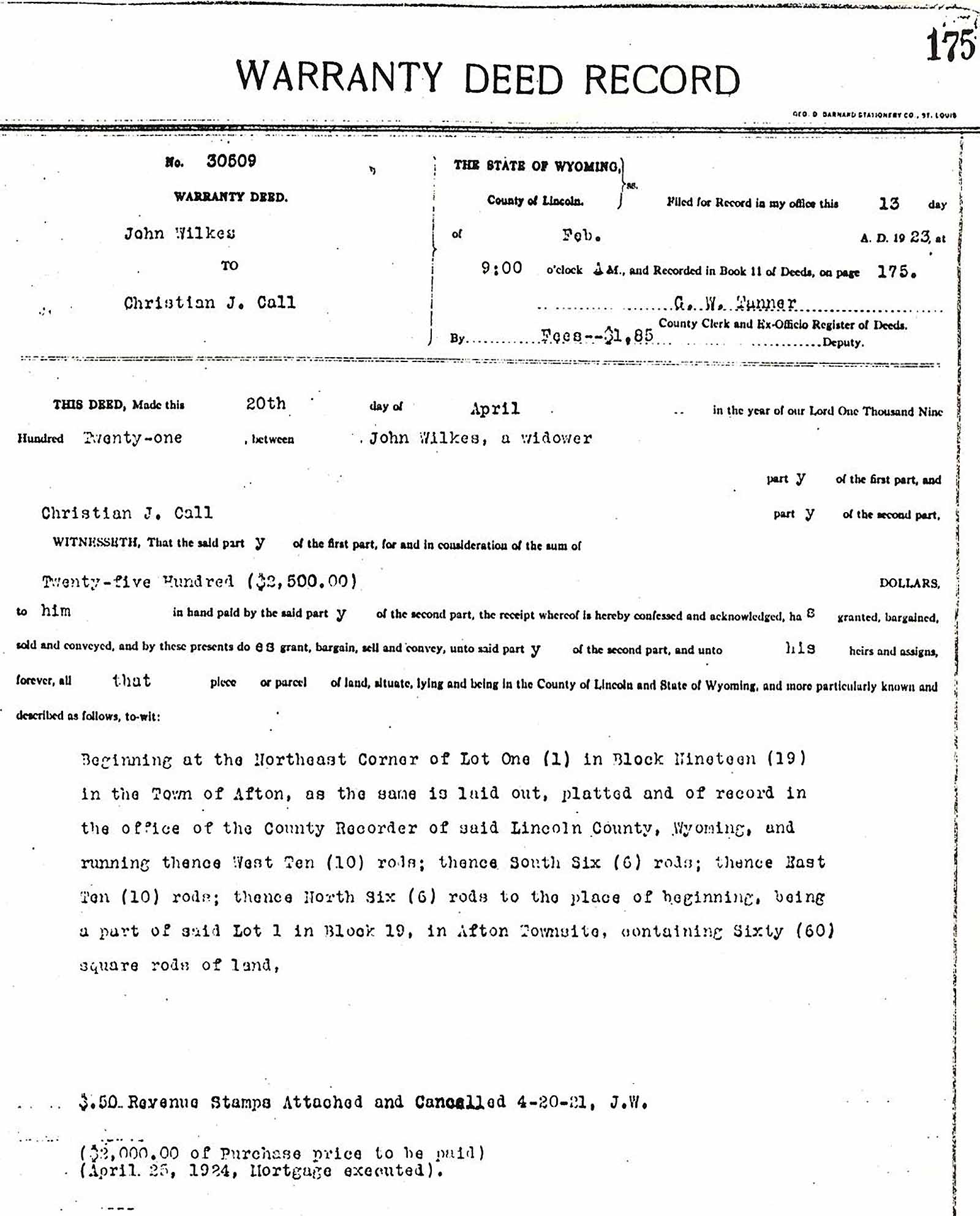
As the writer glances over this brief history of John and Martha Hunt Wilkes, I sense how incomplete the account. At many points along the way I realize much more could have been added at the time and, yet, it was realized there was danger of making it too long. A lot of small detail is not always necessary in order for one to 'get the feel' of the life that actually was lived. On the other hand, far more happens in one's life-span than any simple story can tell. The 58 years covered by Grandma's life-span could have had volumes written as, also, with the 76 years of grandpa's life-span.
Our regrets are that this respected couple didn't leave more written records, in fact, but a single line. Personally, the writer is not aware that a single line has been left by either of them. It is quite possible that somewhere, with one or more branches of the family, there is a letter or a statement of which I am not aware. If there is such in the possession of any one of you descendants, please treasure it.
Two or three items have come to mind which have been gained from hearsay or personal observation which may be here added tho they be out of sequence, rather than make any attempt to return in my writing and insert them in a more logical place. To change the entire manuscript for the sake of adding a related item to that which has already been written would become a mammoth job. Please have forbearance for my not making such an effort.
In answer to a direct question posed to Aunt Mabel in our taped interview with her in May of 1965 relating to church activity in the Wilkes' home, she said: "I never remember of my father ever having gone to church excepting for an occasional funeral service." She went on to state that her mother was a religious person and, whenever possible, she attended her church meetings. At times during the confining years with the boarding house business when regular meals had to be served to the boarders three times a day, she was not free to be away from home.
Aunt Mabel reported that her mother, thru the years, had an assignment as a Relief Society visiting teacher and that she faithfully attended to that duty and that she, Aunt Mabel, as a little girl, often accompanied her mother and her mother's visiting companion.
She also reported that, so far as her brothers and sisters were concerned, all faithfully attended their church meetings and other church activities and most, if not all, participated in the ward choir.
A personal observation: Grandpa Wilkes, so long as I remember him which was all my life, smoked a pipe - from between his teeth the stem of the pipe followed his chin down and then cupped back up to the bowl of the pipe just to the front of his lips. We children were timid when around him, but he took delight at times, as he sat in his hardwood rocker with tied-on cushions to the back and seat, to blow smoke rings into the air above his head. He was good at it and his eyes would twinkle as he saw our amazement and delight. I never heard of him having drinking problems during the later few years of his life. If he drank at all, he seemed to have control. It was regrettable that Grandma Wilkes couldn't have enjoyed him as he was in the latter years, rather than having to contend with his drinking years.
As I remember him in my mind's eye, I would judge that he stood slightly less than six feet - perhaps five feet ten inches. While his hair wasn't heavy on top, he retained enough in his elderly years to have a wave on top. It was snow white as was his mustache and relatively closely trimmed beard. He walked with a limp with his right foot which always required a specially built shoe with a solid leather high heel, perhaps from three inches to, perhaps slightly higher. This shoe, also, had a heavy sole. For the last twelve to fifteen years, he had but his right arm. His left arm shirt-sleeve was folded and pinned at his shoulder.
He was a quiet man and quite unassuming. I cannot overly stress the fact he was a good man - a fine gentleman.
Notation has already been made that he spent most of his last ten years in the home of Aunt Luella, first in Burley - but a year or two - and the balance in her home in Pocatello where he assisted with her grocery business even to assisting on the 'floor' at times when they were busy. She had a very active corner neighborhood grocery store on North Main Street.
Grandpa Wilkes passed away on the 10th of June 1928 at the age of 76 years and 8 months plus at Pocatello and his body was taken to Afton where he was buried at the side of Grandma Wilkes who had preceded him in death by over 13 years.
At the time of his passing the following children were living: Aunt Mattie Walker; Uncle Ed; Aunt Lottie Barker; Hettie Blacker; Uncle Noen; Aunt Lola Holbrook; and Aunt Mabel Brown.
This writer was on my mission in Ireland, having been in the mission field nearly six months. Grandpa Wilkes had passed away and was buried some time before I was aware of the sad news, but I shall never forget the day I received word from Mother of his passing - the 28th day of June 1928. It was a Saturday afternoon, and by coincidence, that evening my companion and I were mobbed while holding an open-air street meeting in Ballymena, Ireland, about 30 miles north of Belfast, by several hundred irate Irish men and women. This resulted in our finding it advisable, and in accord with the suggestions of a fine police-force, our friends, and the recommendation of our mission president, President John A. Widtsoe, to find another locality in which to continue our missionary labors.
The date of learning of Grandpa's passing was indelibly stamped on my consciousness by this coincidence. No lasting damage resulted from the incident. At the time, there was not a known member of the Church within 30 miles of Ballymena. Today, (1984) it is reported there is a branch with their own chapel.
Commencing with the next chapter, an attempt will be made to briefly review the lives of each of the children, in order of birth, of Grandpa and Grandma. Each of these accounts will be brief. In some cases, just as their brief history was written by them personally or by one of their children. In the first place the plan was to write of the Wilkes family ancestry only, including Grandpa and Grandma. This much has been concluded with this chapter. Hopefully, each of us has learned a little of our forebearers and, to have become sufficiently informed of their individual lives that we can more fully appreciate the part each of them played in our lives to make us who we are.
It certainly is needless for us to say we are grateful for each of them. When each of us again meet them in another world, we will each have a big thank-you to offer them for agreeing with us in our pre-mortal life that they would be willing to lead the way in this earthlife and come first to take, so to speak, 'the heat of the day' that we, their descendants, would not have the hardships they were willing to endure for us. So sure as we live today, so sure will we each meet them and renew our acquaintance which we once had with them before we came into this mortal life.
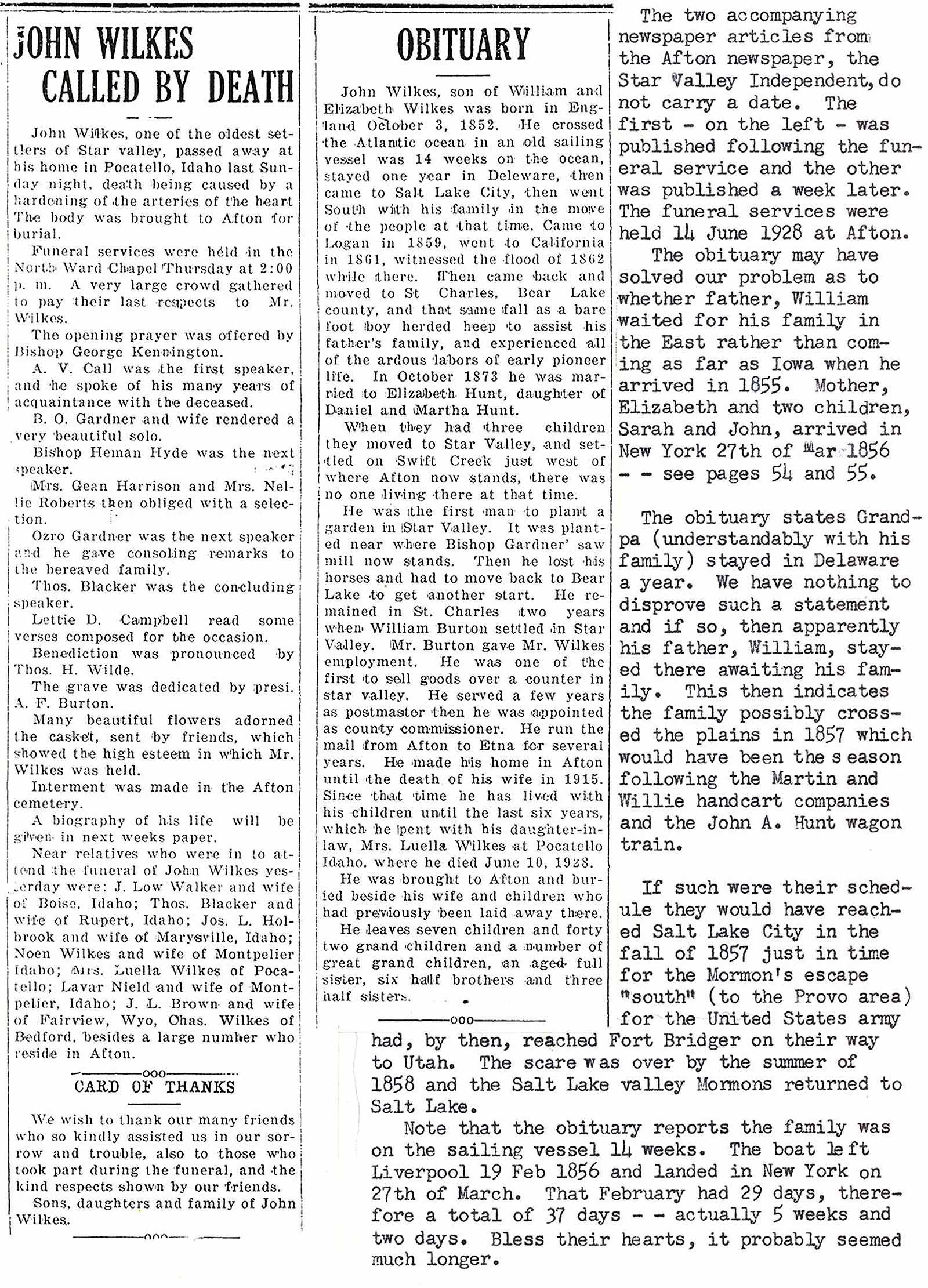
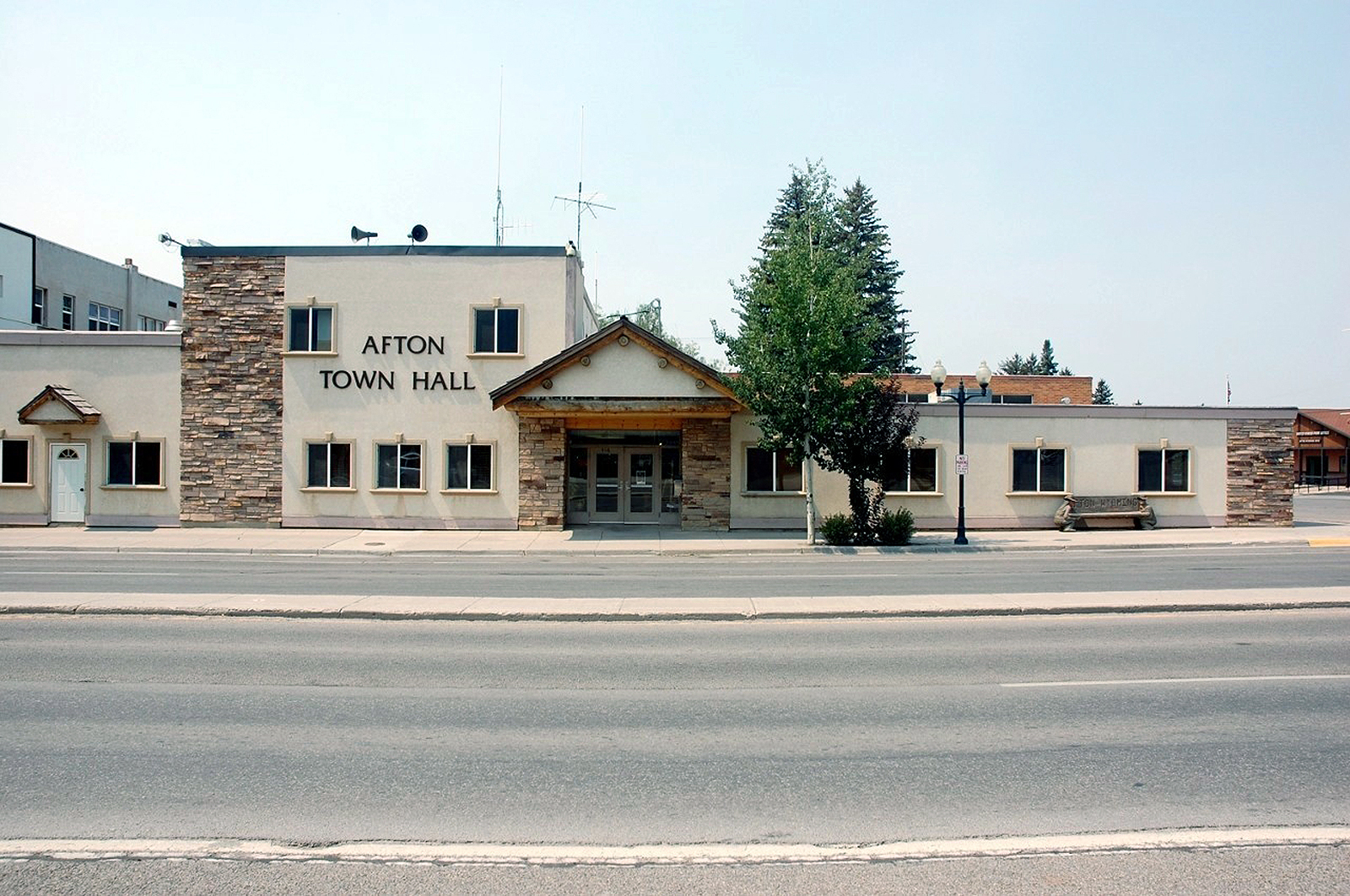 For a family member not acquainted with early Afton, it will not be difficult
to locate former sites of family history first by becoming acquainted with the
maps of the area and/or driving to central Afton of today and locating the Afton
town hall and offices as shown in the above picture. This town office center
sits on the spot where the first Wilkes' town home was constructed about 1895
- - one of the early frame houses of the Valley. The frame house stood for nearly
30 years when it was sold by Grandpa Wilkes to one Christian Call of the second
generation of the Call family in Afton. He built a modern service station after
razing the old Wilkes' dwelling. The service station served the community for
many years and within the last decade the property was purchased by the City
of Afton for its modern-day office facility.
For a family member not acquainted with early Afton, it will not be difficult
to locate former sites of family history first by becoming acquainted with the
maps of the area and/or driving to central Afton of today and locating the Afton
town hall and offices as shown in the above picture. This town office center
sits on the spot where the first Wilkes' town home was constructed about 1895
- - one of the early frame houses of the Valley. The frame house stood for nearly
30 years when it was sold by Grandpa Wilkes to one Christian Call of the second
generation of the Call family in Afton. He built a modern service station after
razing the old Wilkes' dwelling. The service station served the community for
many years and within the last decade the property was purchased by the City
of Afton for its modern-day office facility.
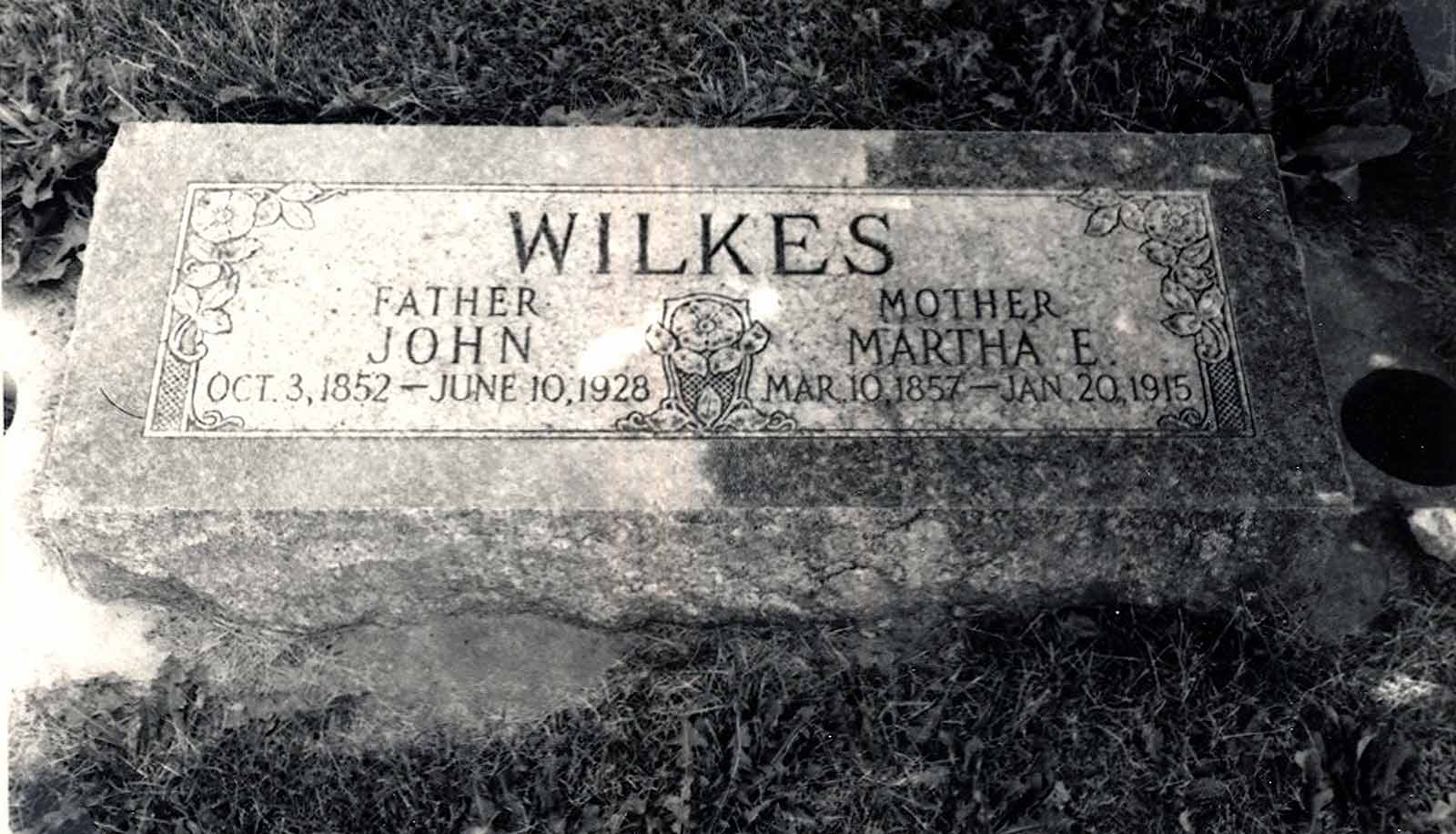 As one enters the Afton cemetery and walks toward its mid-center, it will not
be difficult to find any number of Wilkes family-member or other related headstones.
The above picture shows Grandpa and Grandma Wilkes headstone.
As one enters the Afton cemetery and walks toward its mid-center, it will not
be difficult to find any number of Wilkes family-member or other related headstones.
The above picture shows Grandpa and Grandma Wilkes headstone.
 Each of the above children will appear with his or her companion and their children
and children's children to include the last marriage and the last birth. providing
those involved are willing to share the information. These records will be included
in their order toward the last of this history.
Each of the above children will appear with his or her companion and their children
and children's children to include the last marriage and the last birth. providing
those involved are willing to share the information. These records will be included
in their order toward the last of this history.
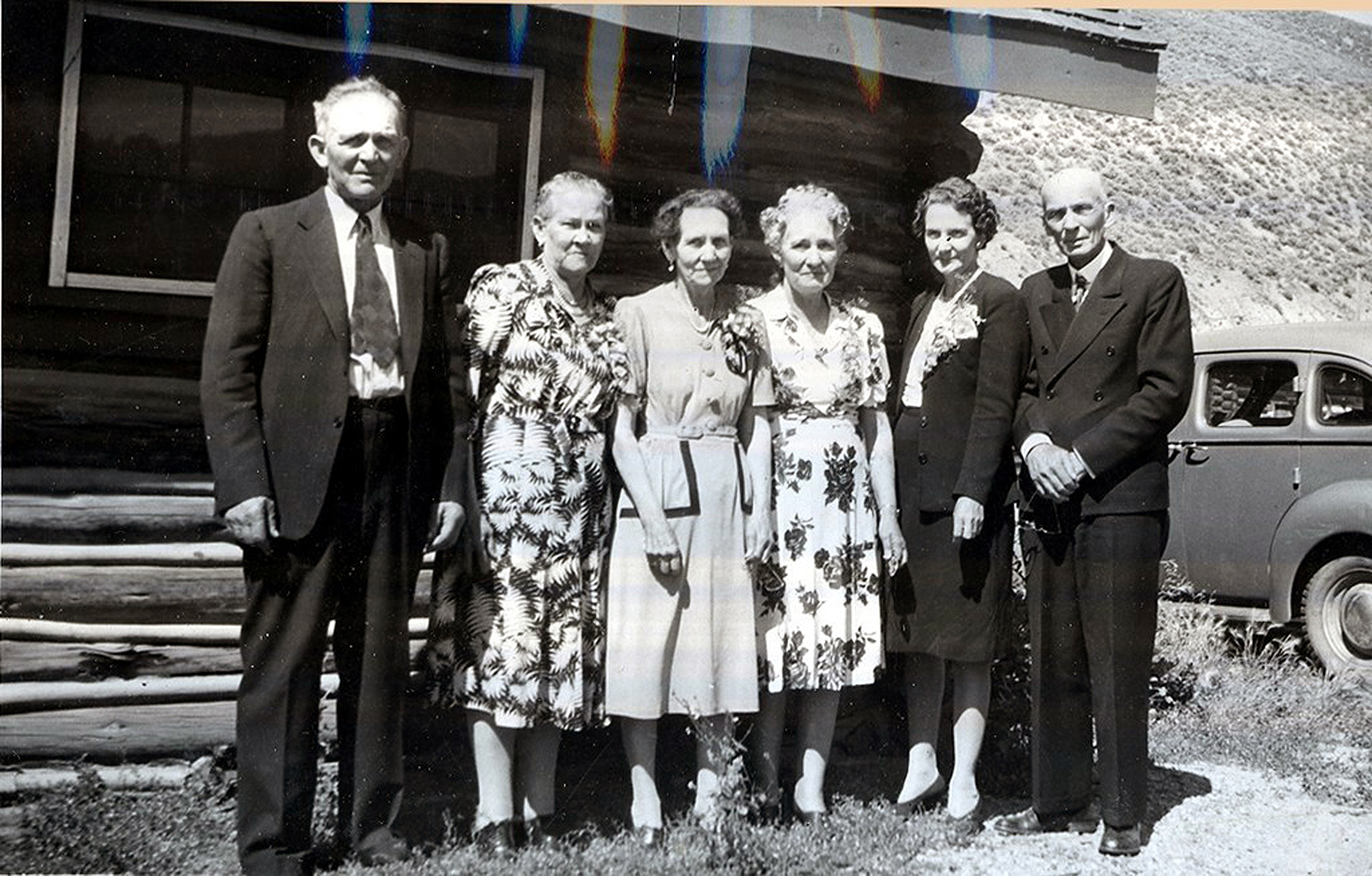 John and Martha Wilkes children taken at a family reunion held in Fairview, Wyoming
about 1946. Left to right: Uncle Noen (Benoni Gashum Moroni), Aunt Lottie (Charlotte Ann) Barker, Aunt Mattie (Martha Elizabeth) Walker,
Hettie Blacker, Aunt Mabel Brown and Uncle Ed (William Edmond). Aunt Lola (Sarah Leola) Holbrook was absent.
John and Martha Wilkes children taken at a family reunion held in Fairview, Wyoming
about 1946. Left to right: Uncle Noen (Benoni Gashum Moroni), Aunt Lottie (Charlotte Ann) Barker, Aunt Mattie (Martha Elizabeth) Walker,
Hettie Blacker, Aunt Mabel Brown and Uncle Ed (William Edmond). Aunt Lola (Sarah Leola) Holbrook was absent.
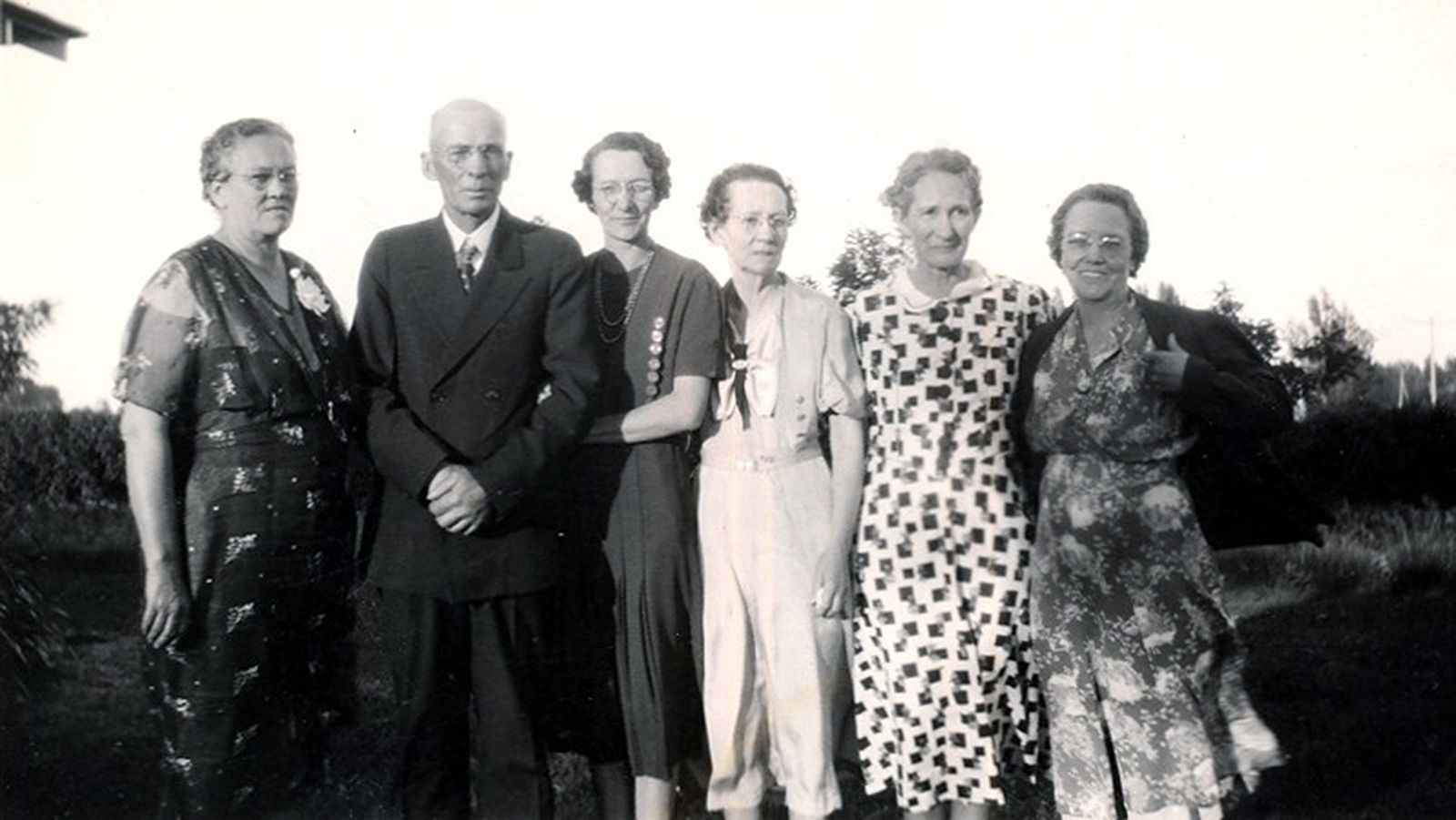 This picture shows six of the seven children of the same family, this time Uncle
Noen (Benoni Gashum Moroni) is absent. Picture taken at a family reunion in Rupert, Idaho left to right:
Aunt Lottie (Charlotte Ann) Barker, Uncle Ed (William Edmond), Aunt Mabel Brown, Aunt Mattie (Martha Elizabeth) Walker, Hettie Blacker
and Luella Wilkes (John's widow). About 1939.
This picture shows six of the seven children of the same family, this time Uncle
Noen (Benoni Gashum Moroni) is absent. Picture taken at a family reunion in Rupert, Idaho left to right:
Aunt Lottie (Charlotte Ann) Barker, Uncle Ed (William Edmond), Aunt Mabel Brown, Aunt Mattie (Martha Elizabeth) Walker, Hettie Blacker
and Luella Wilkes (John's widow). About 1939.
 A portion of the group attending the John Wilkes Family Organization reunion
at Rupert, Idaho 1938. Front row: Idella Walker, Arvilla Wilkes, Aunt Luella
Wilkes, Hettie Blacker with granddaughter Kay Blacker, June Brown, Aunt Mabel
Brown. Second row: Frank Walker, Pearl Walker Oldham and baby, Aunt Lottie (Charlotte Ann) Barker,
Uncle Hy Barker, Aunt Mattie (Mary Elizabeth) Walker, Uncle Ed (William Edmond) Wilkes, Mary Wilkes, Uncle Lorain
Brown, Valene Brown. Third row: Unknown, Unknown, Jessie Blacker, Hyrum
A portion of the group attending the John Wilkes Family Organization reunion
at Rupert, Idaho 1938. Front row: Idella Walker, Arvilla Wilkes, Aunt Luella
Wilkes, Hettie Blacker with granddaughter Kay Blacker, June Brown, Aunt Mabel
Brown. Second row: Frank Walker, Pearl Walker Oldham and baby, Aunt Lottie (Charlotte Ann) Barker,
Uncle Hy Barker, Aunt Mattie (Mary Elizabeth) Walker, Uncle Ed (William Edmond) Wilkes, Mary Wilkes, Uncle Lorain
Brown, Valene Brown. Third row: Unknown, Unknown, Jessie Blacker, Hyrum
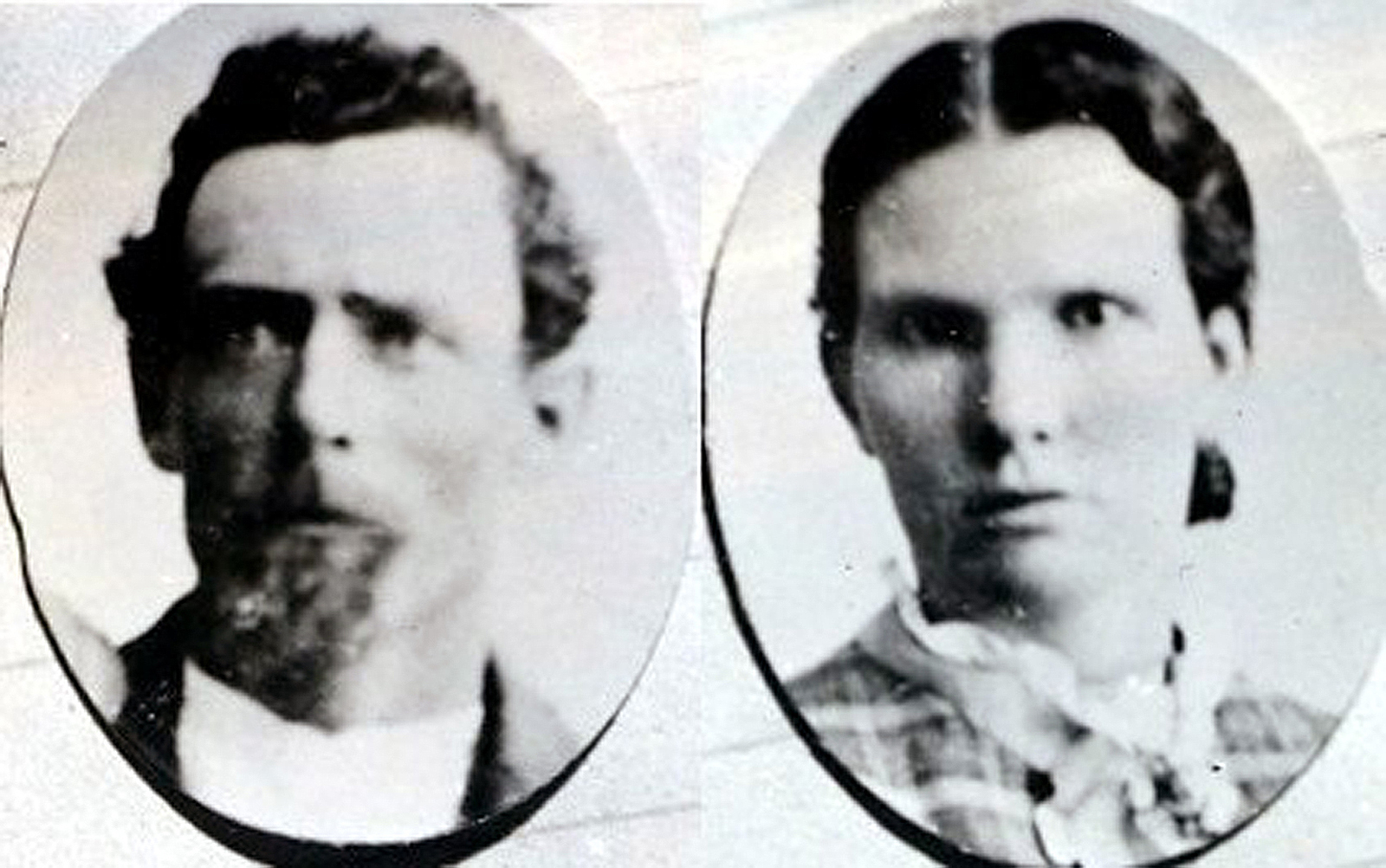 John and Martha Elizabeth Wilkes. Pictures taken near the time of their move to Star Valley
John and Martha Elizabeth Wilkes. Pictures taken near the time of their move to Star Valley
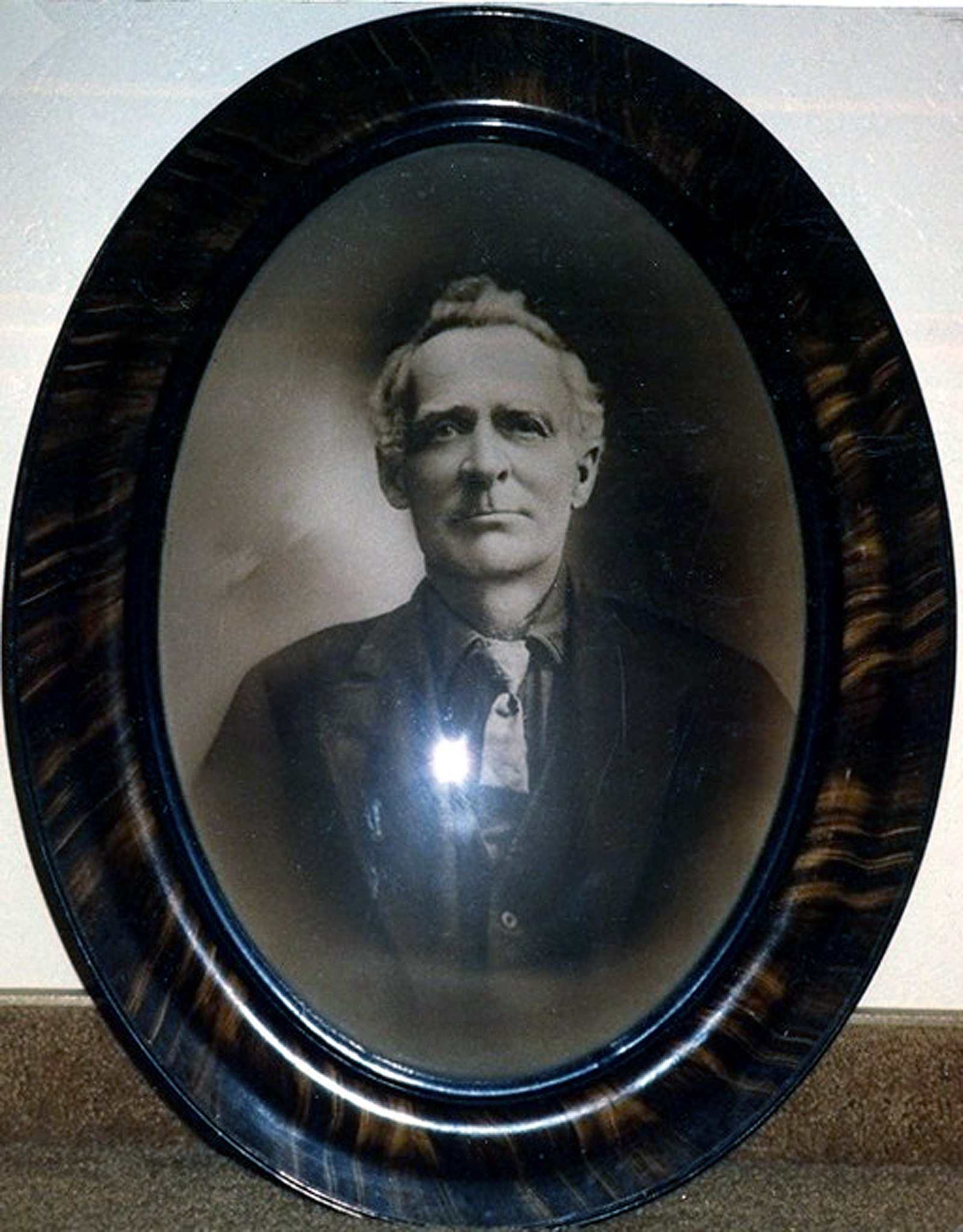 Grandpa John Wilkes as he appeared in his later years. Picture taken about 1920.
Grandpa John Wilkes as he appeared in his later years. Picture taken about 1920.
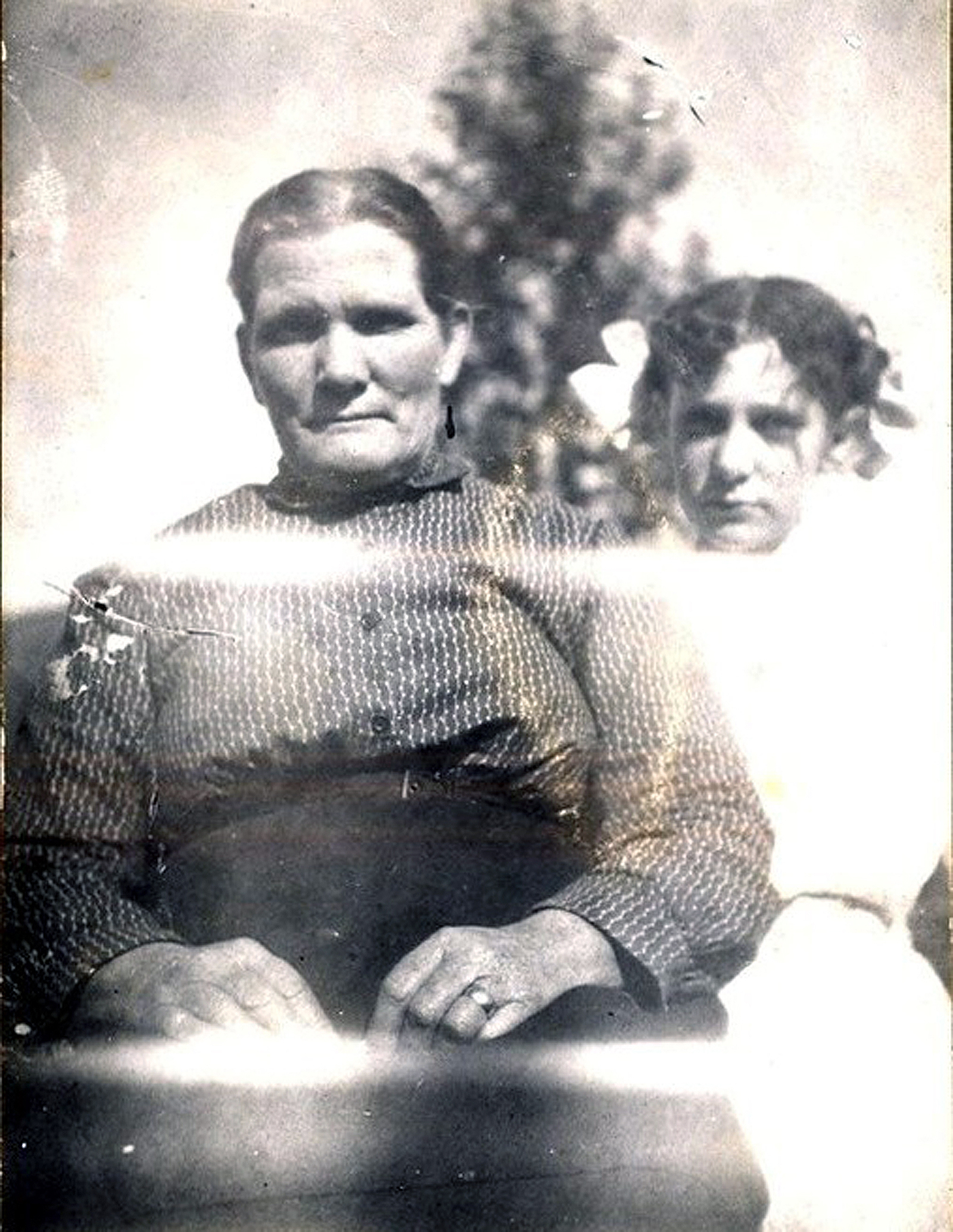 Grandma Martha Elizabeth Hunt Wilkes and youngest daughter, Mabel, about 1912.
Grandma Martha Elizabeth Hunt Wilkes and youngest daughter, Mabel, about 1912.
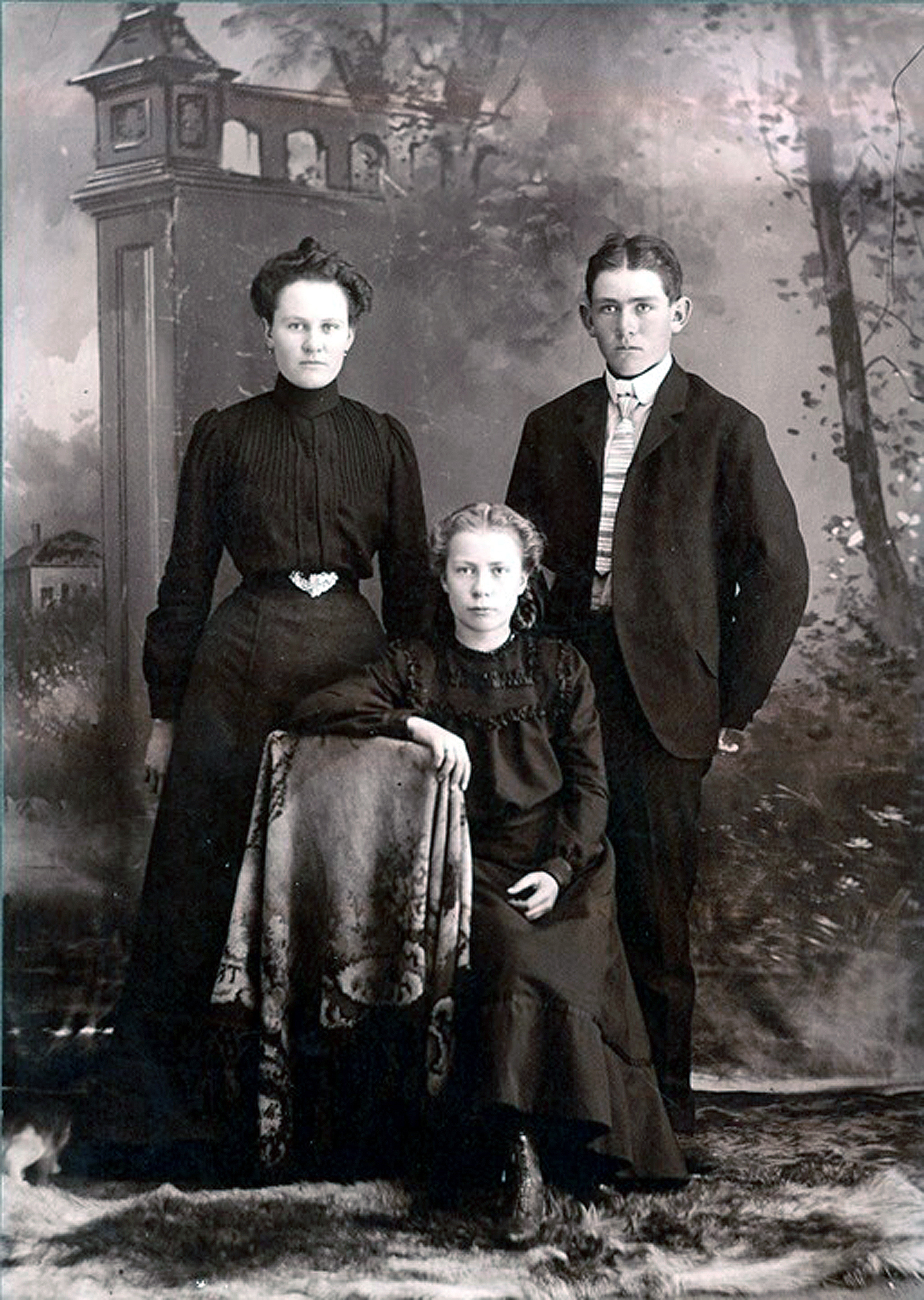 Back: Lottie (Charlotte Ann) Wilkes, Noen (Benoni Gashum Moroni) Wilkes. Front: Leola (Sarah Leola) Wilkes. About 1903
Back: Lottie (Charlotte Ann) Wilkes, Noen (Benoni Gashum Moroni) Wilkes. Front: Leola (Sarah Leola) Wilkes. About 1903
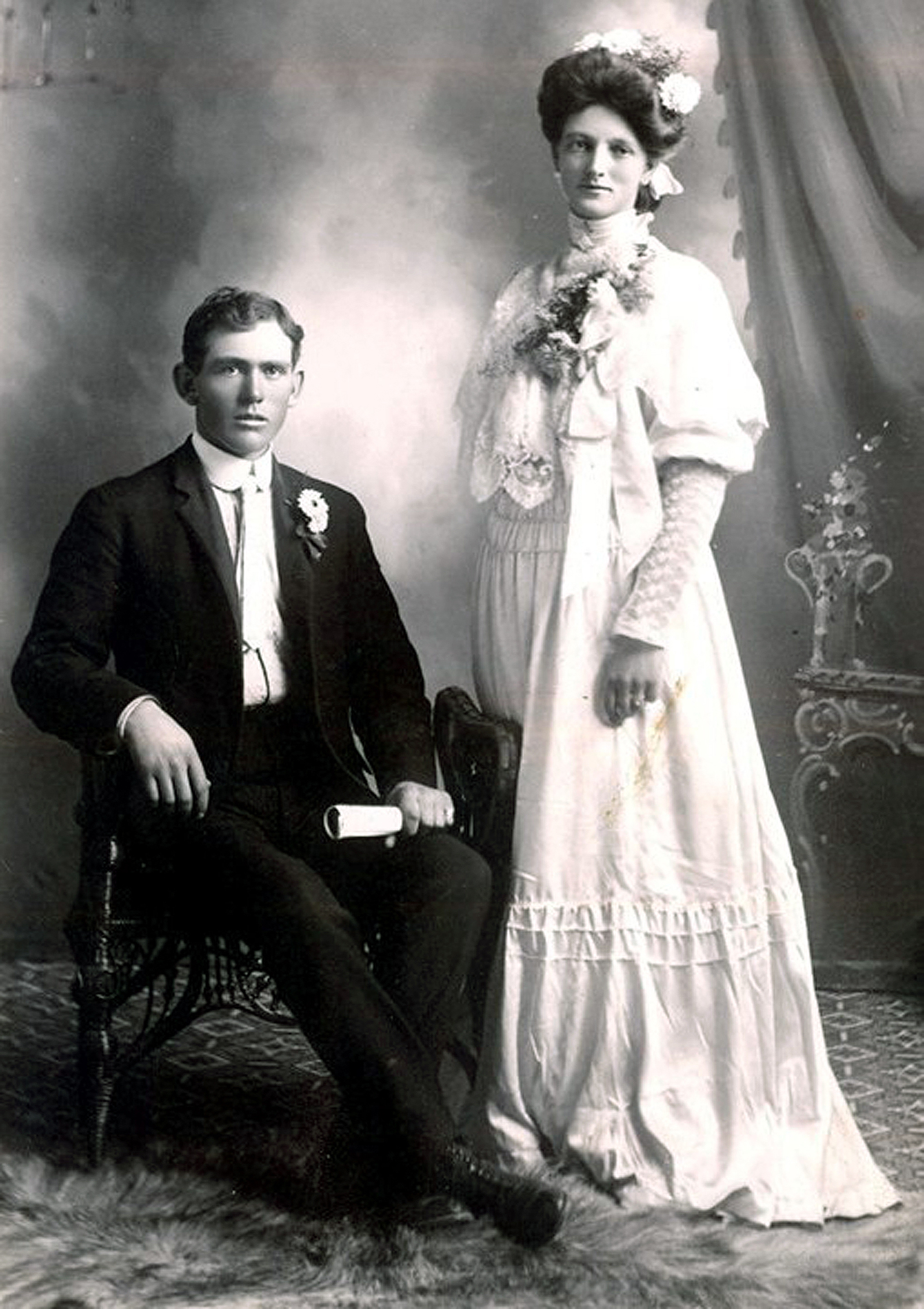 Noen (Benoni Gashum Moroni) and Mamie Lindsay Wilkes, Wedding Day - 11 October, 1905
Noen (Benoni Gashum Moroni) and Mamie Lindsay Wilkes, Wedding Day - 11 October, 1905